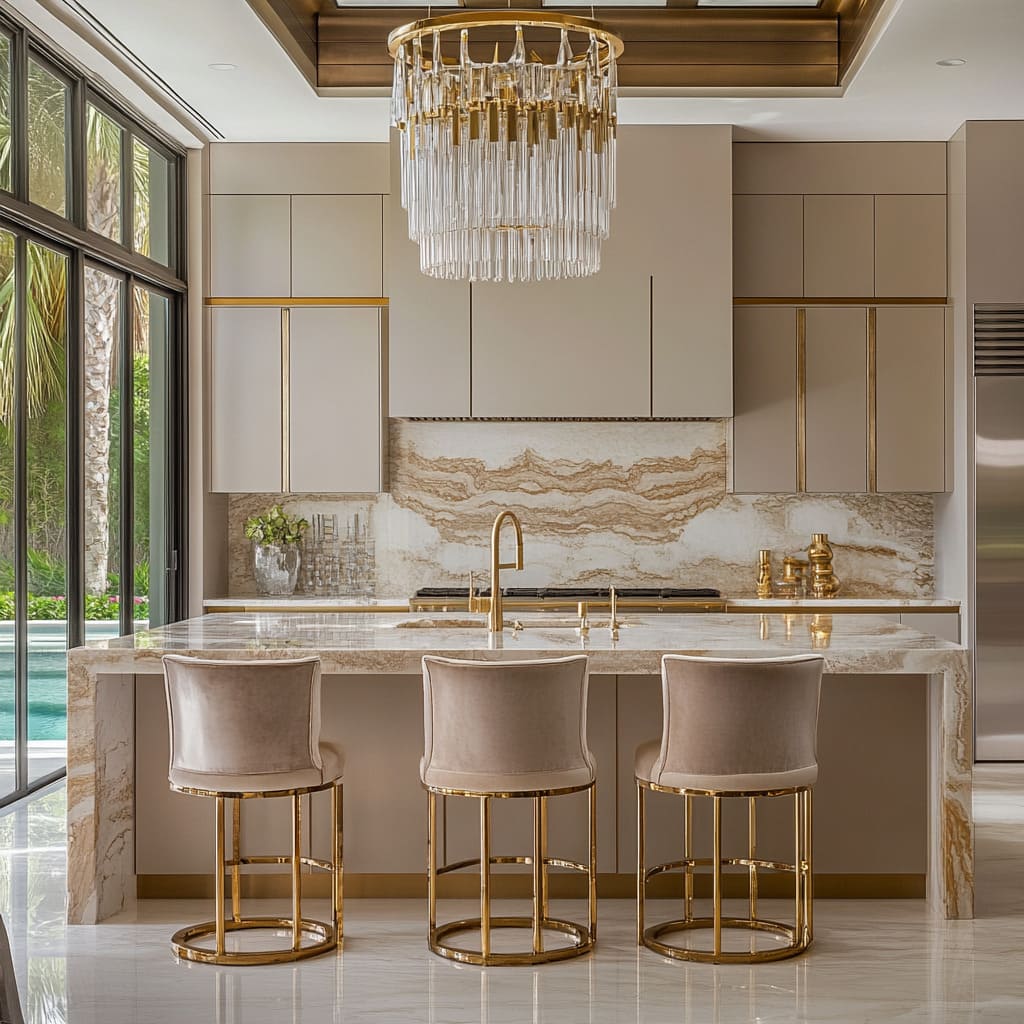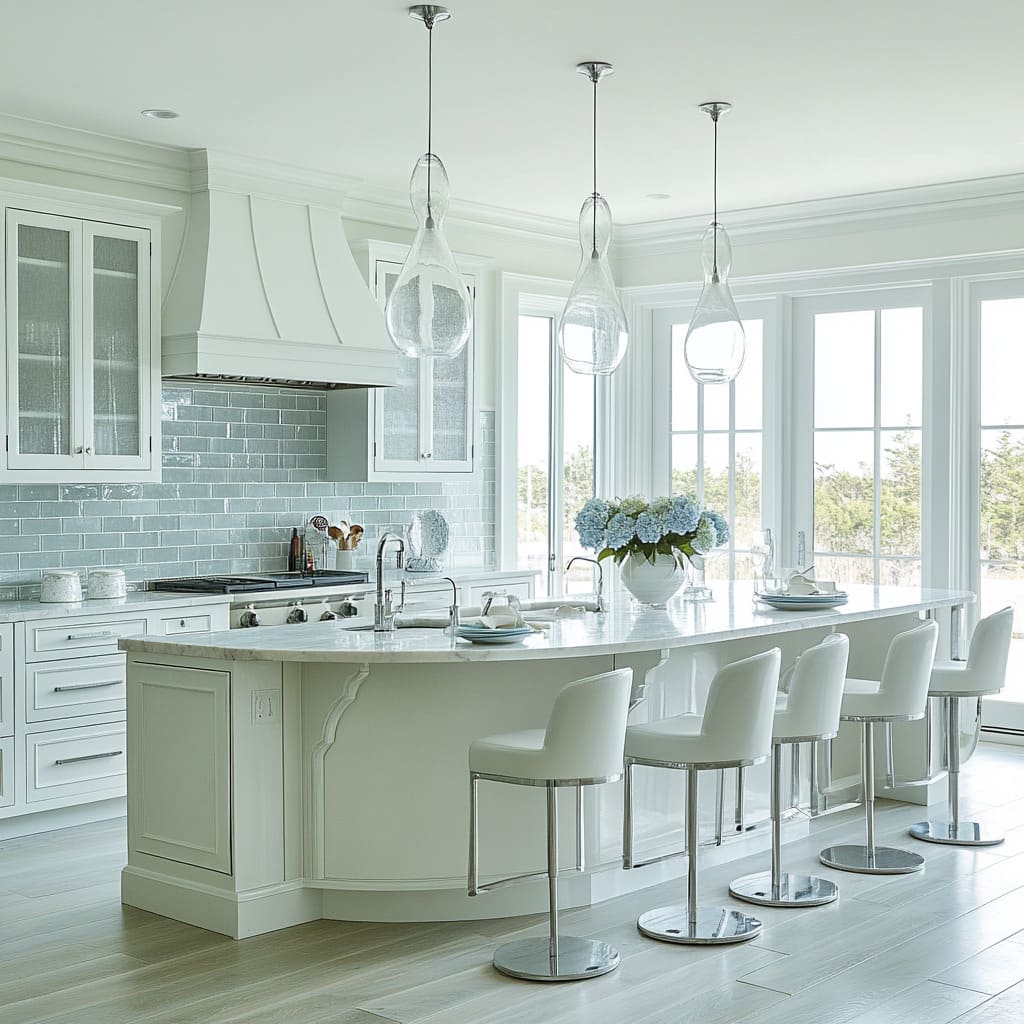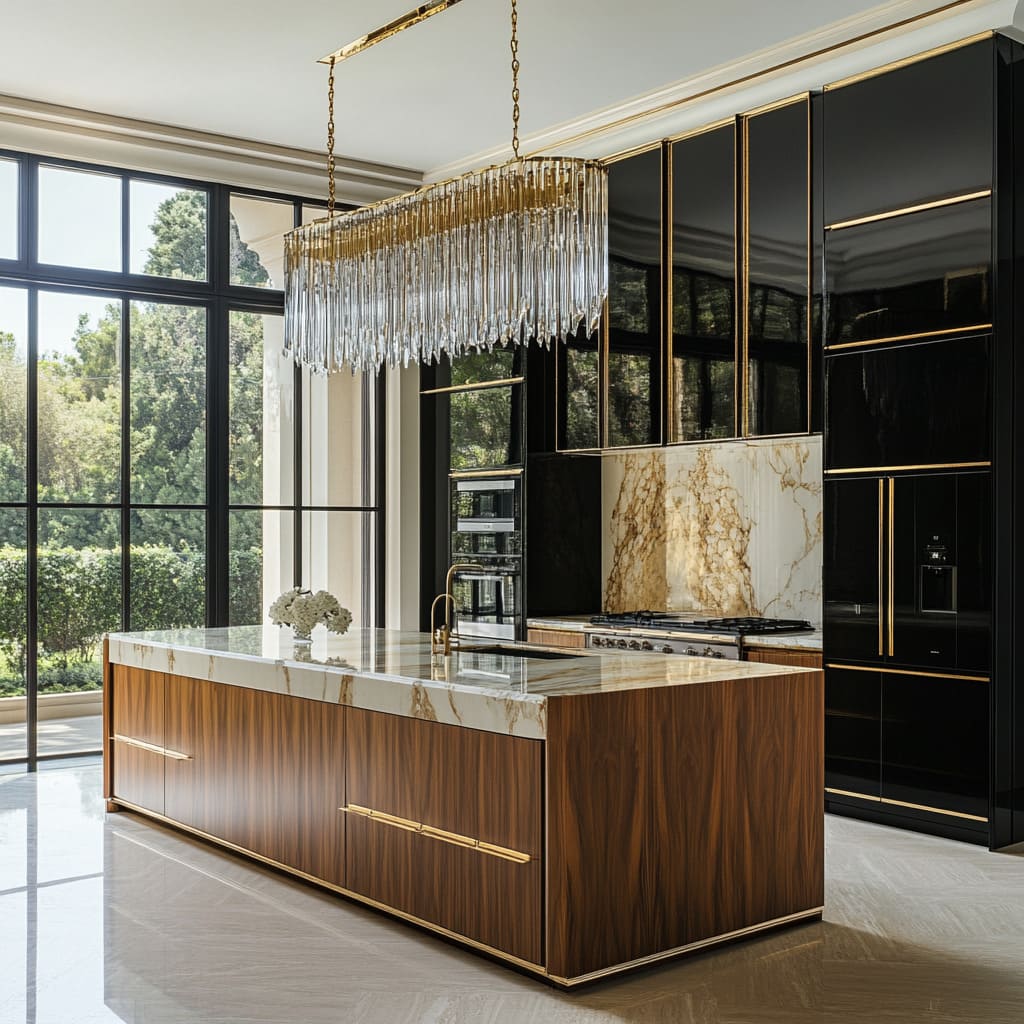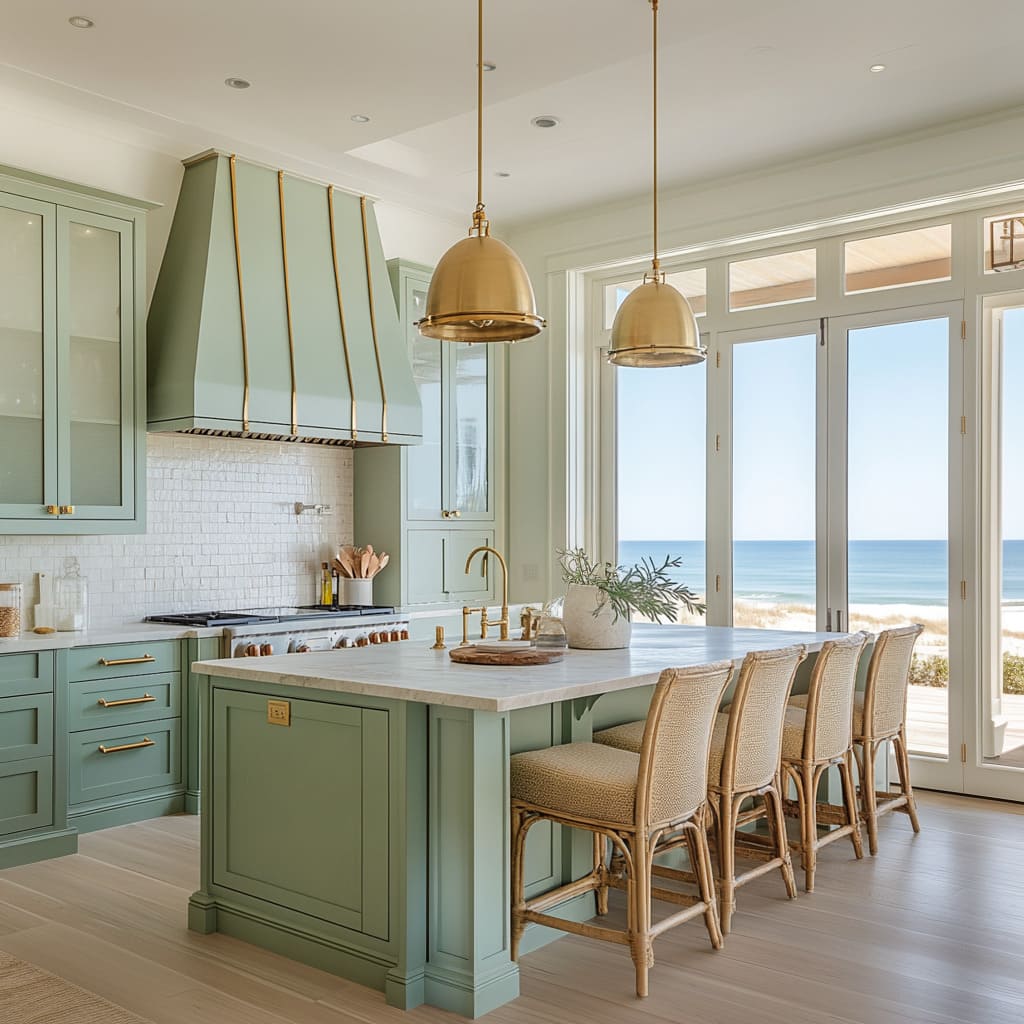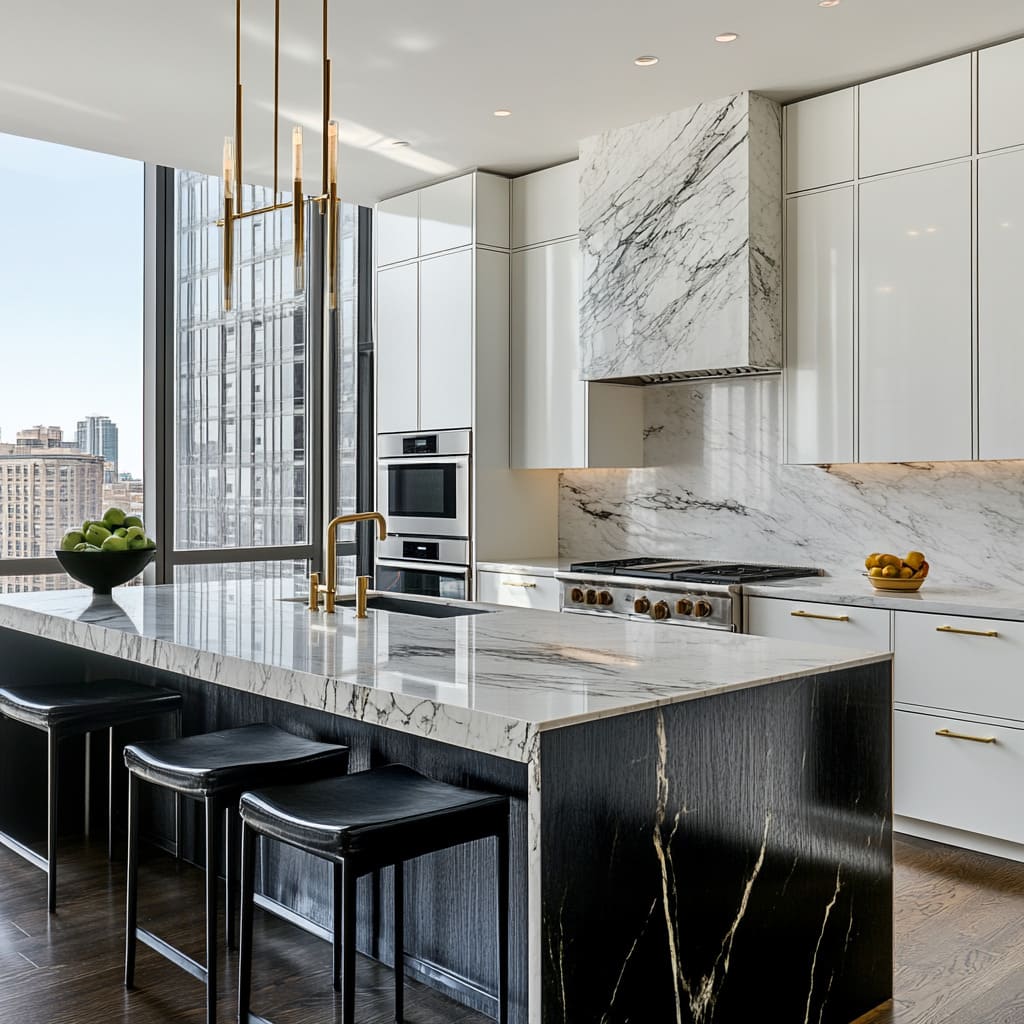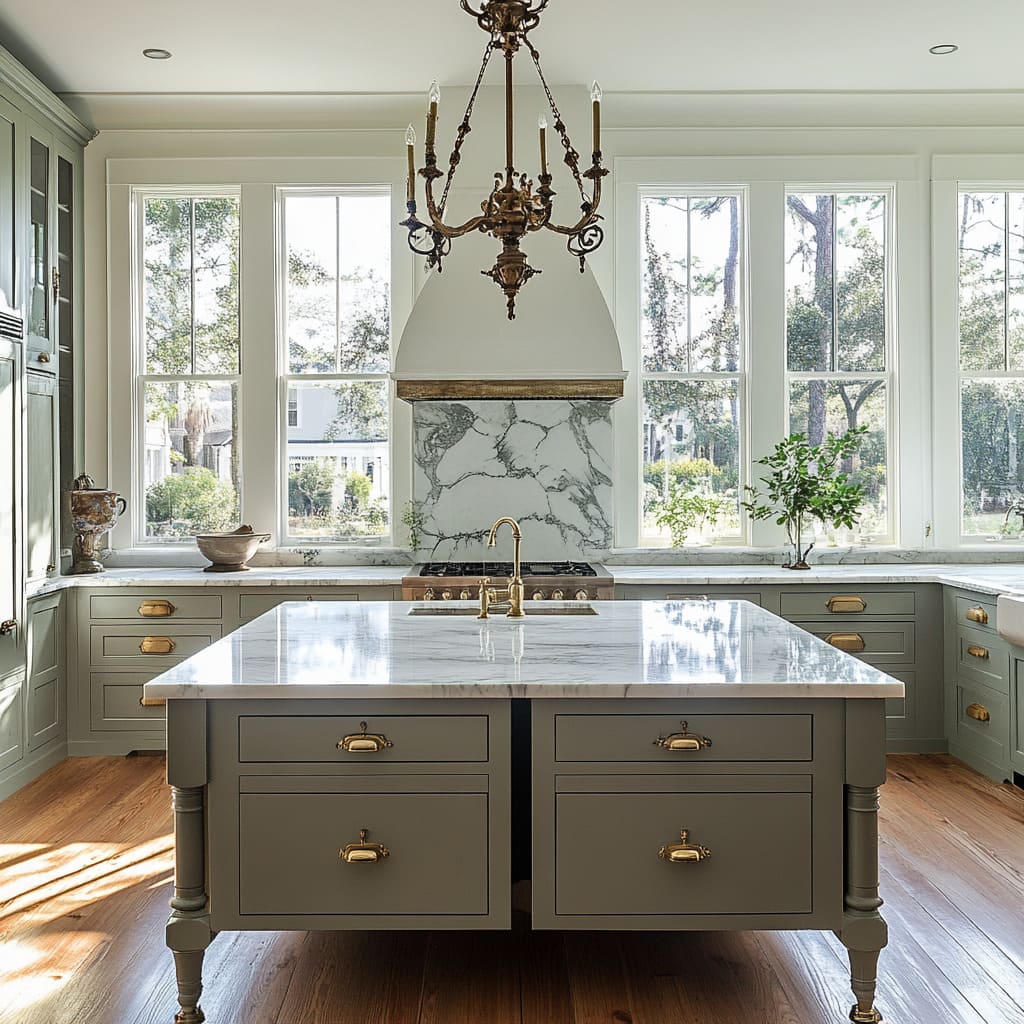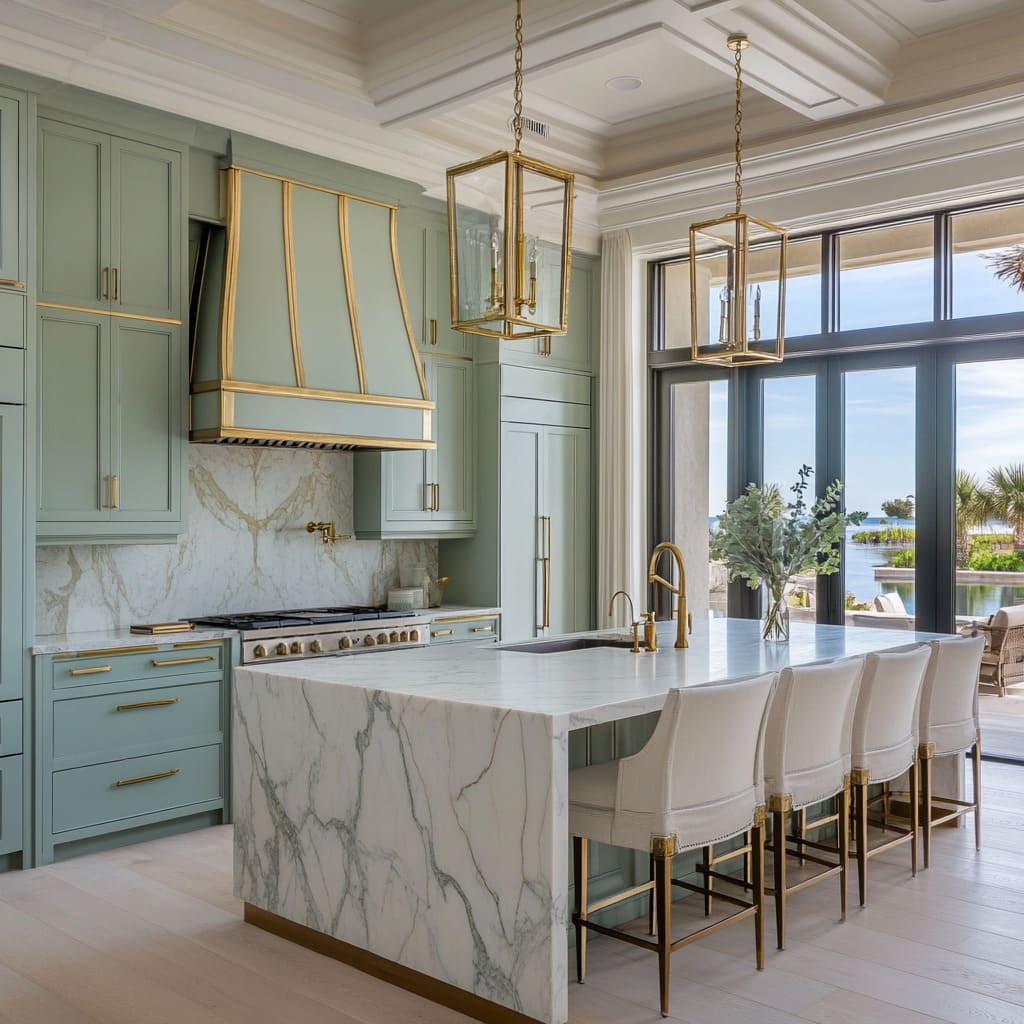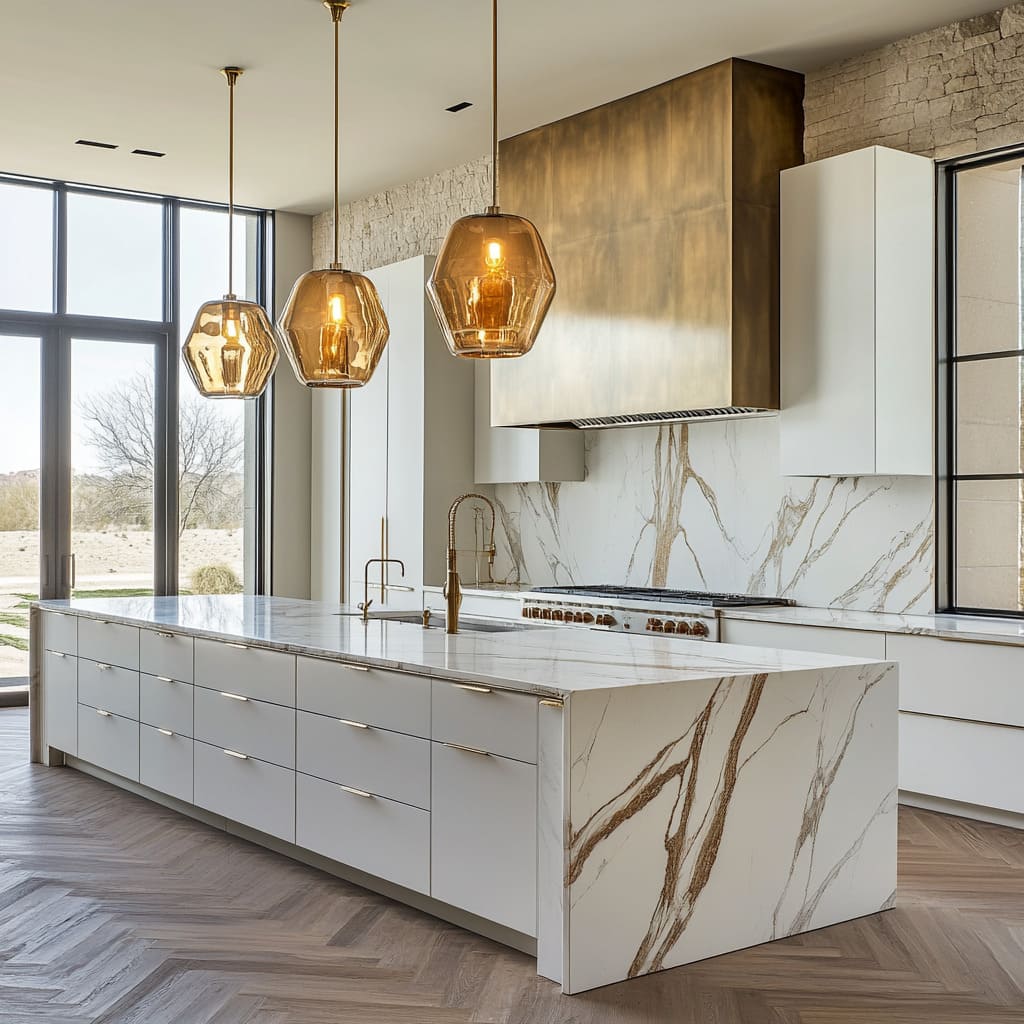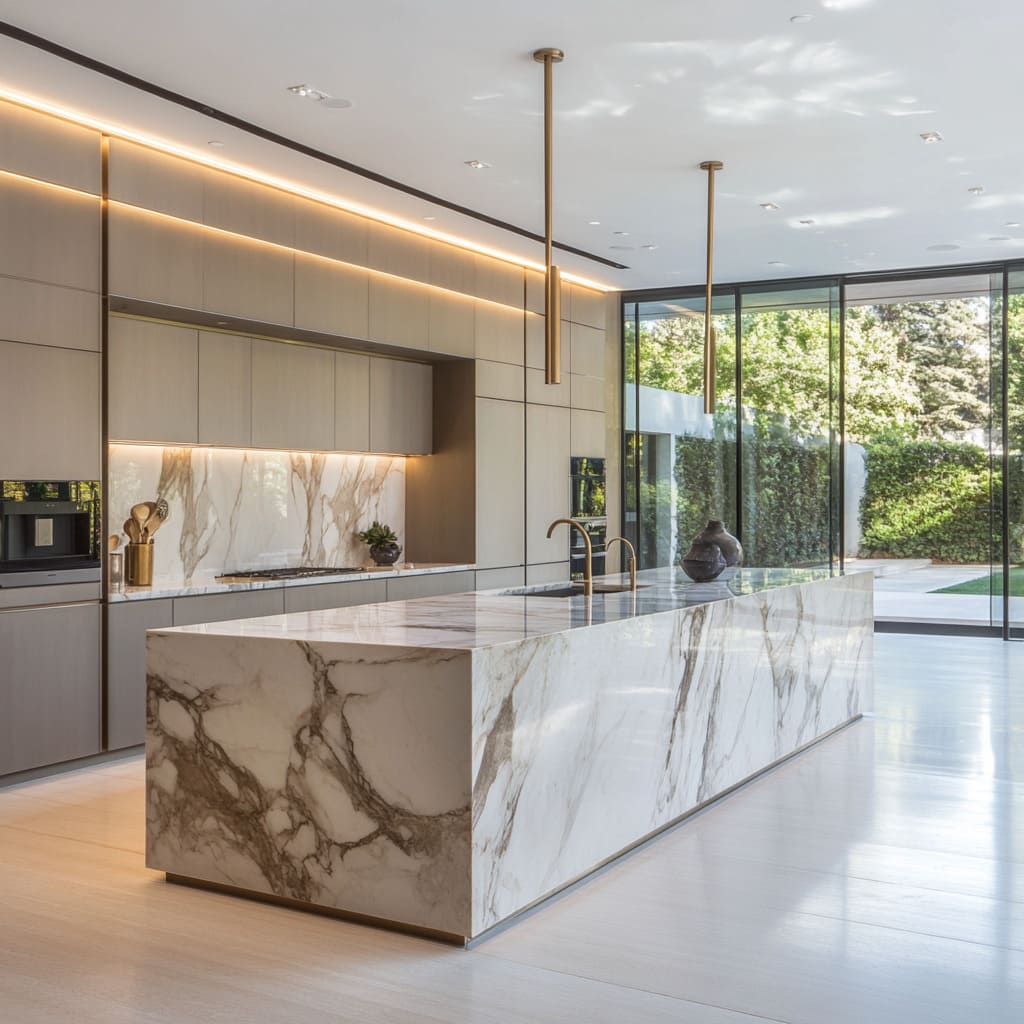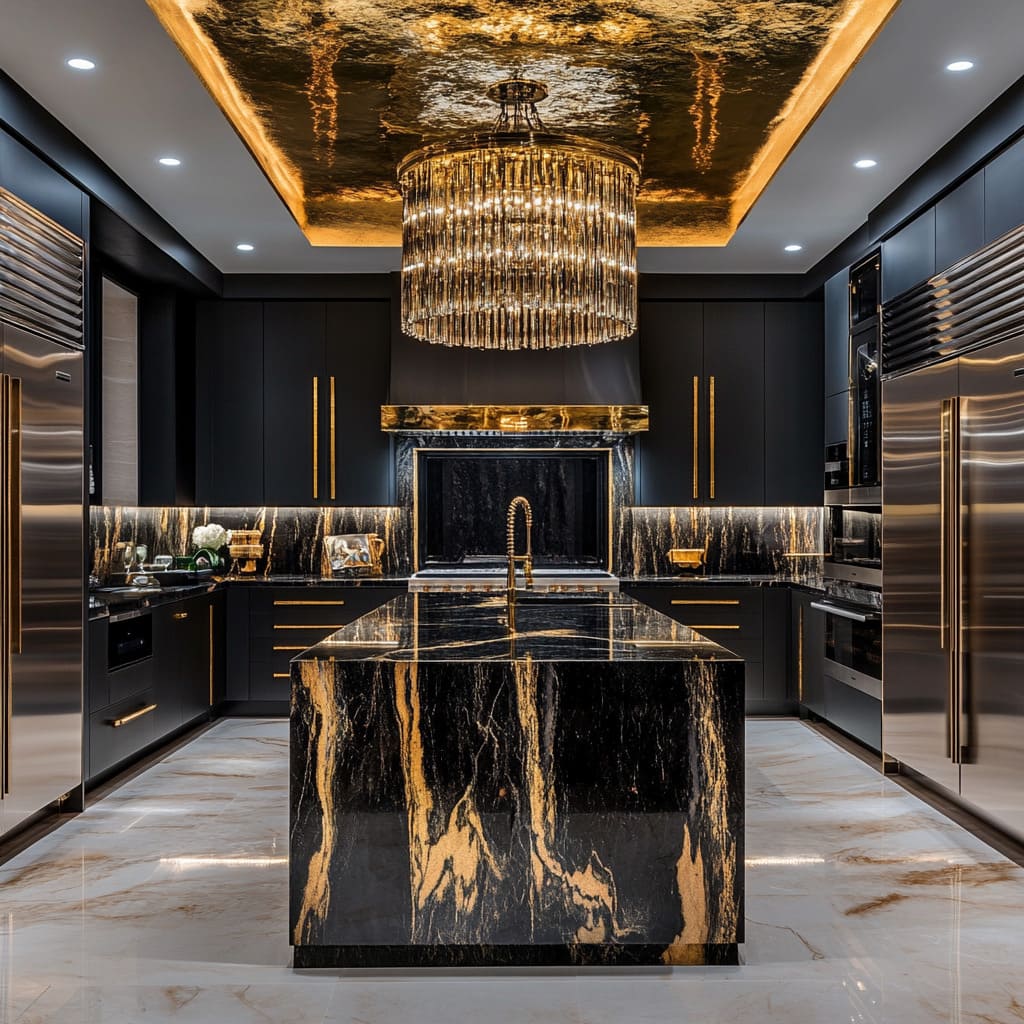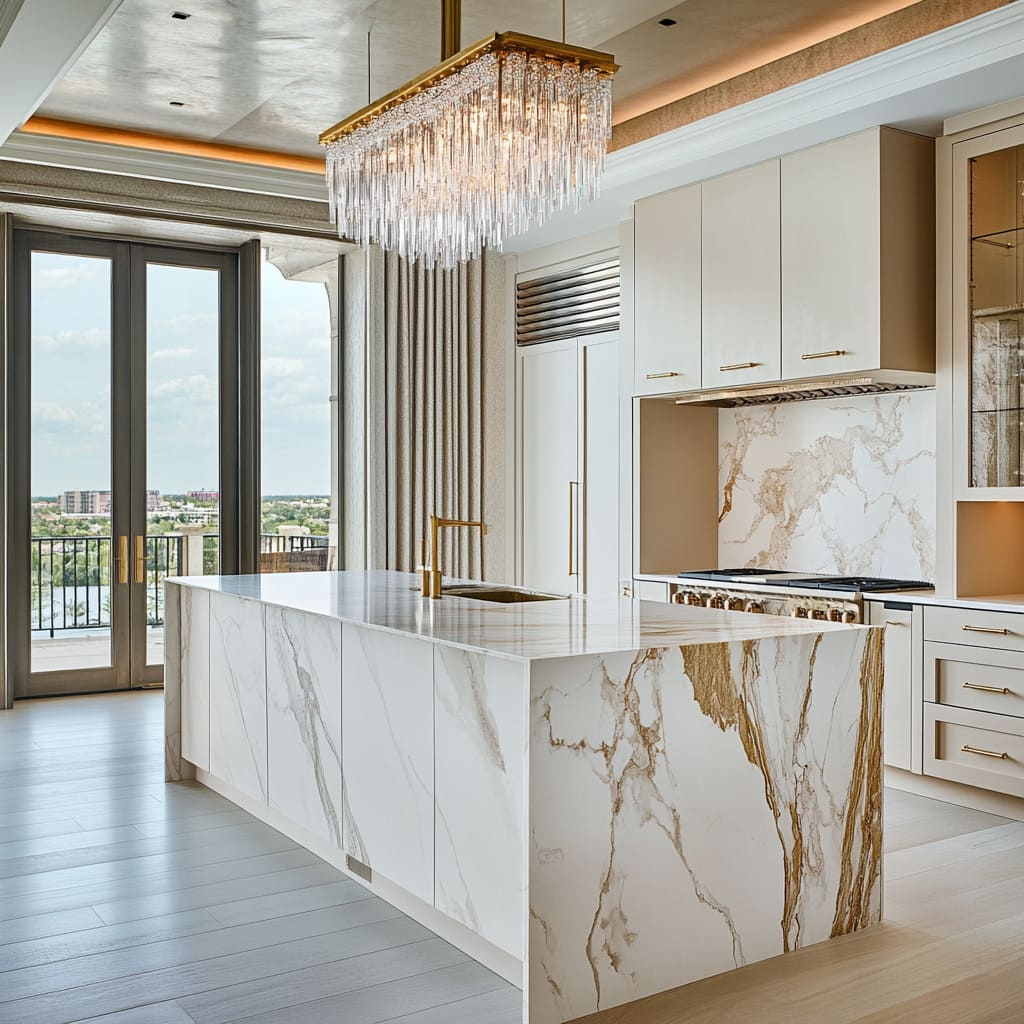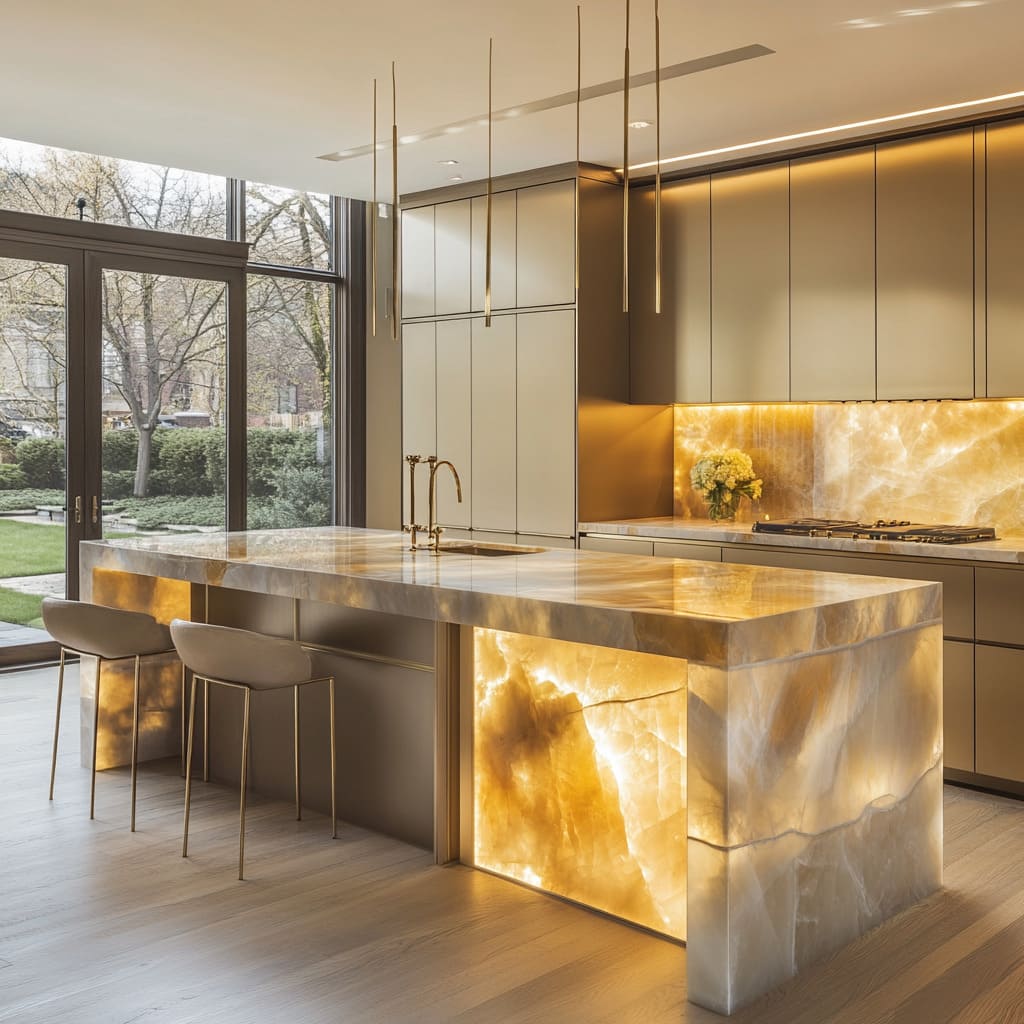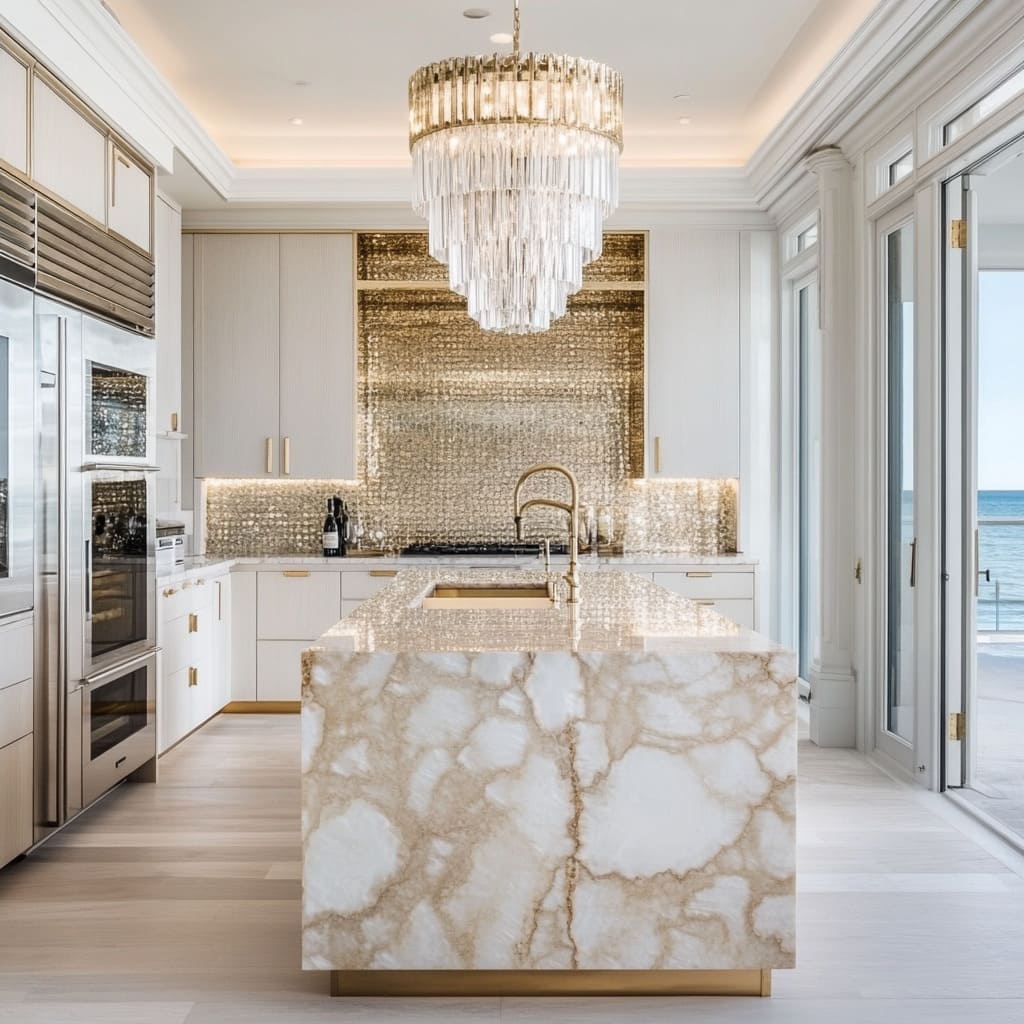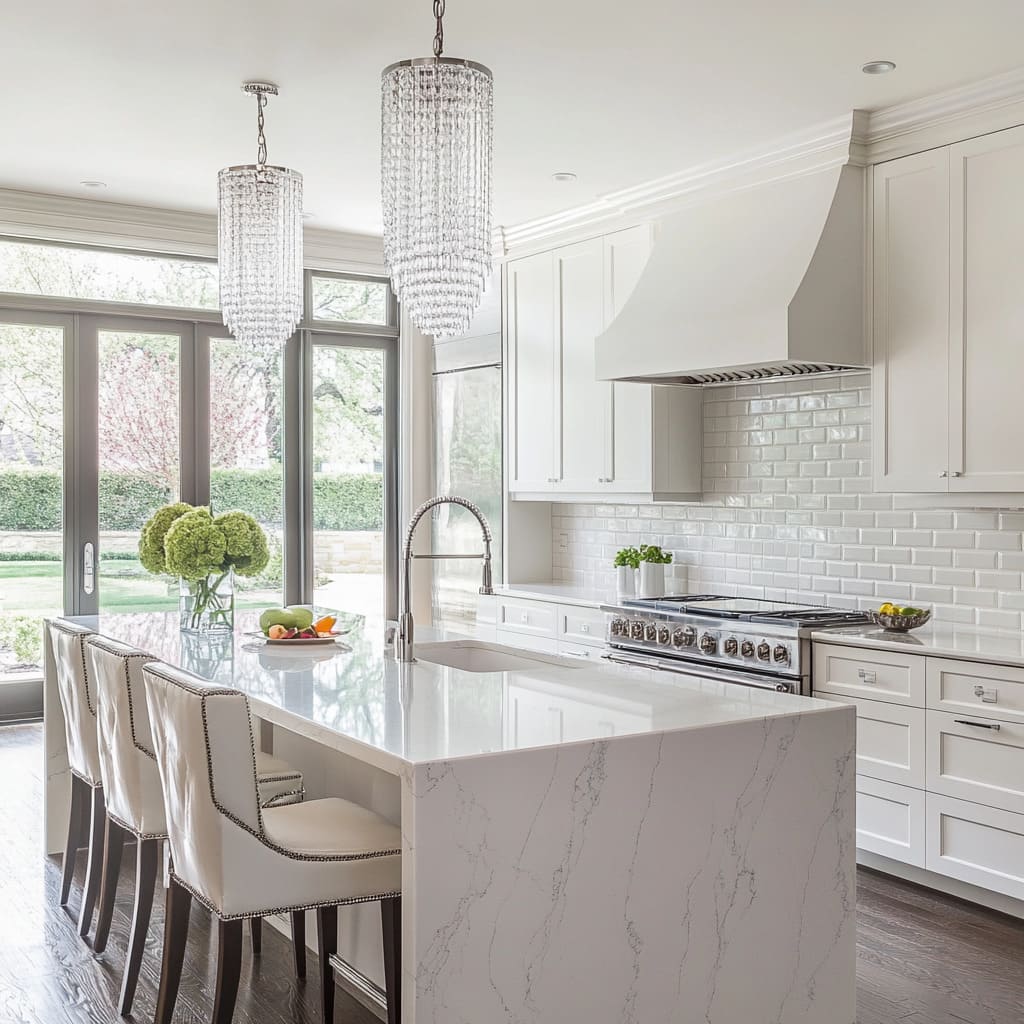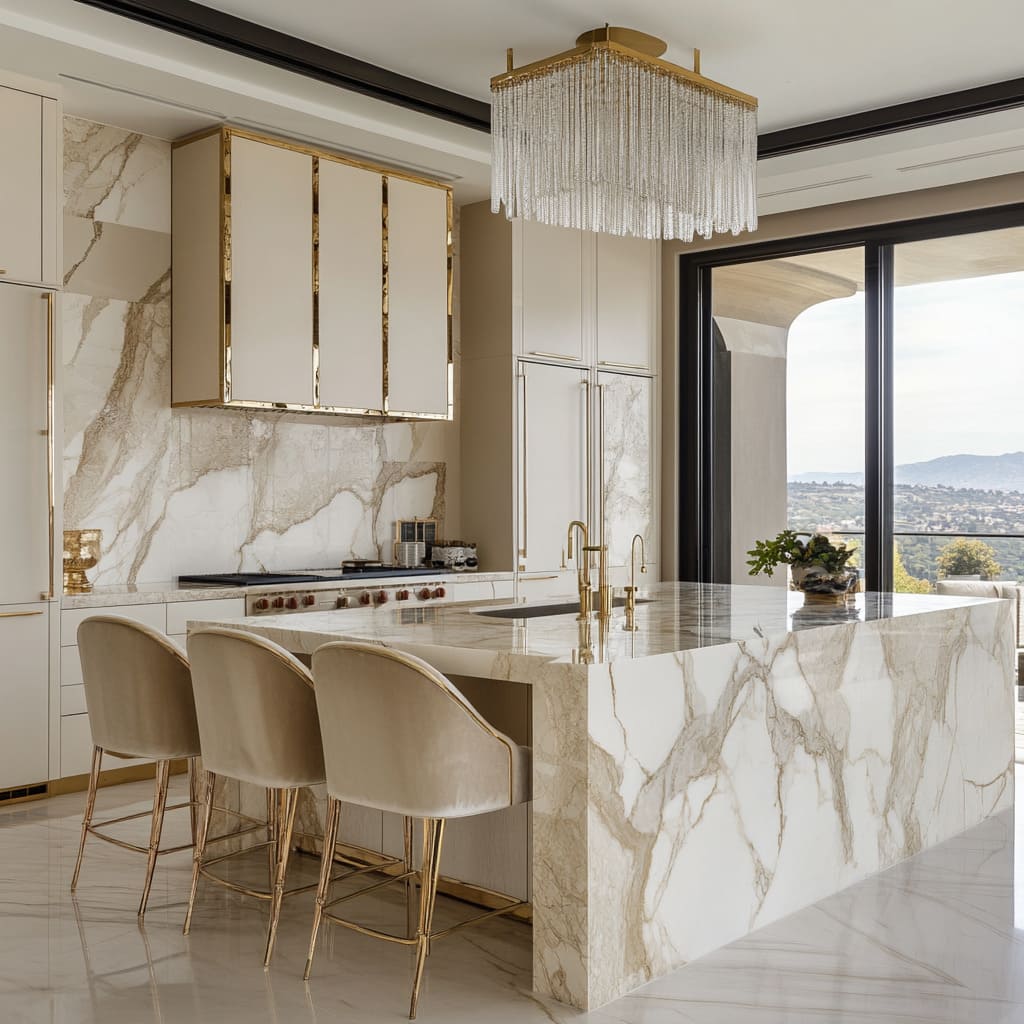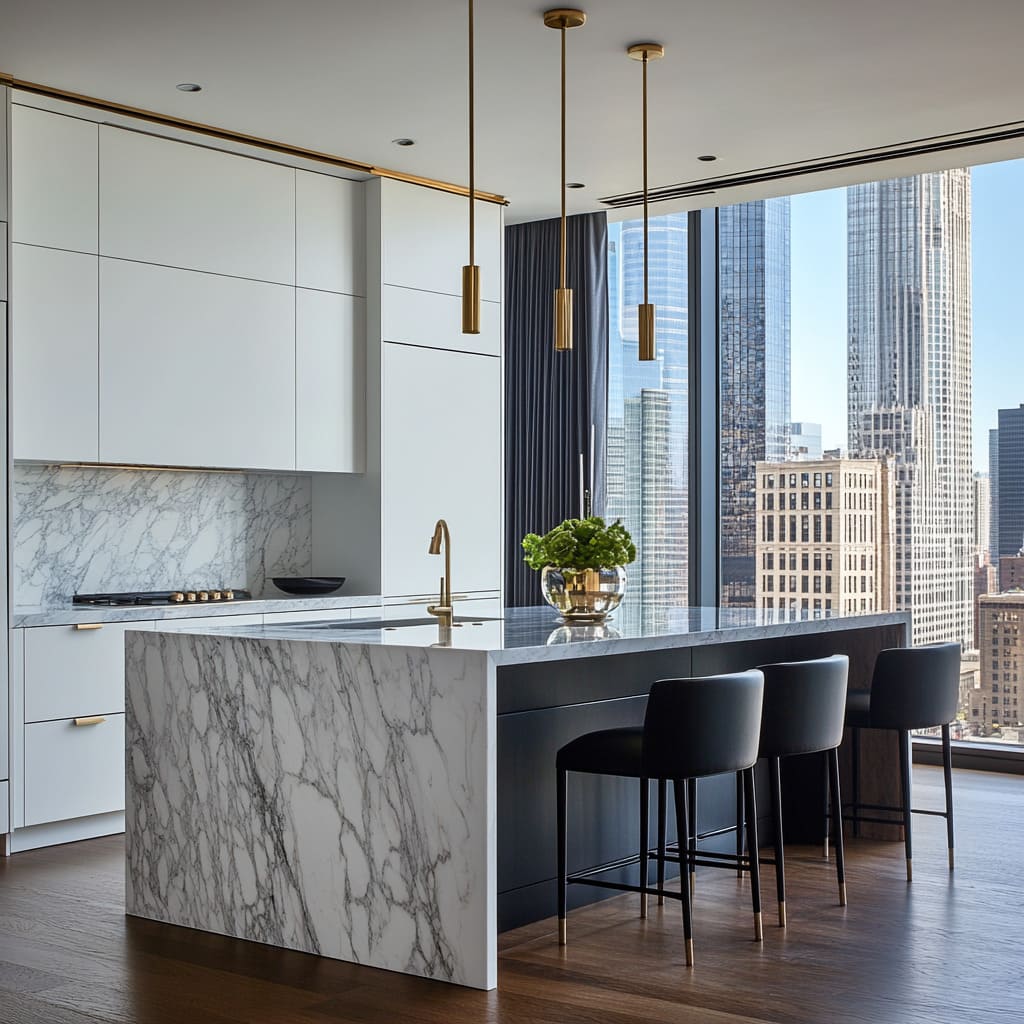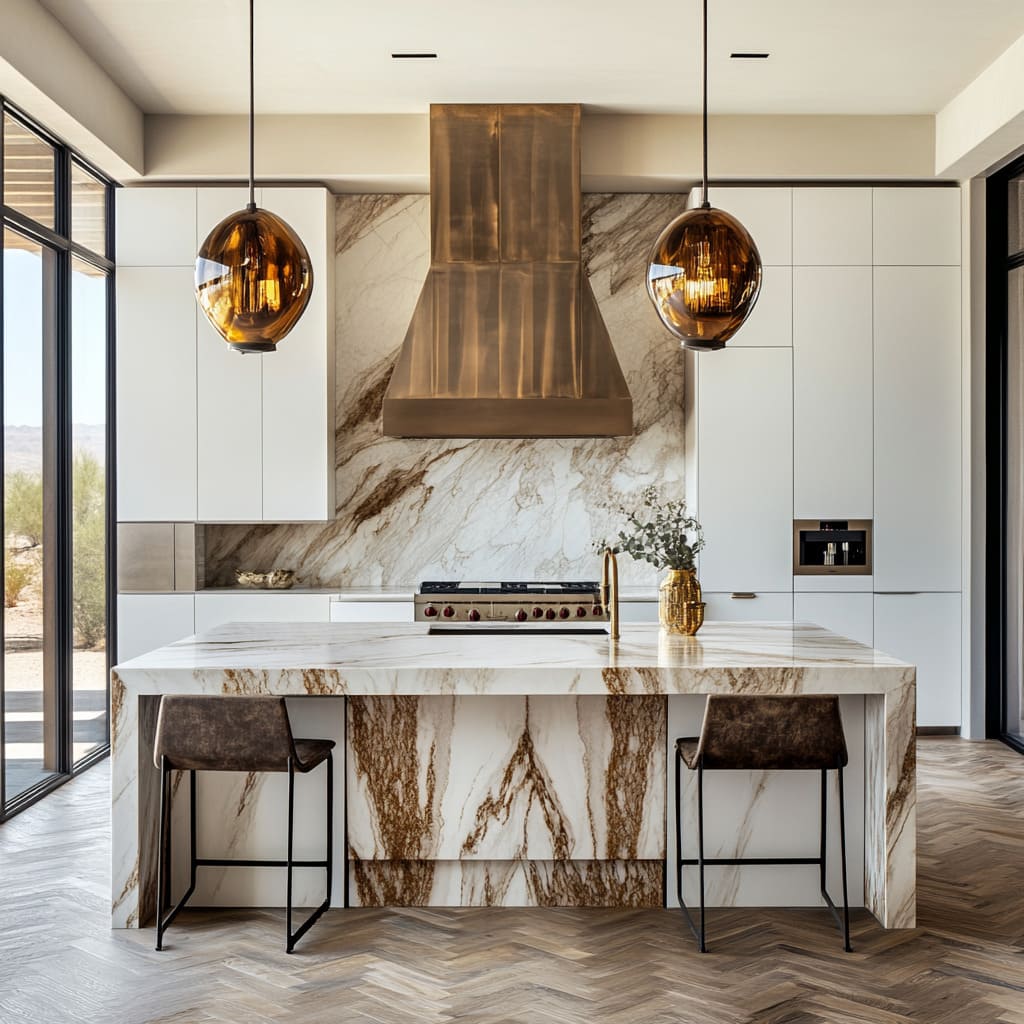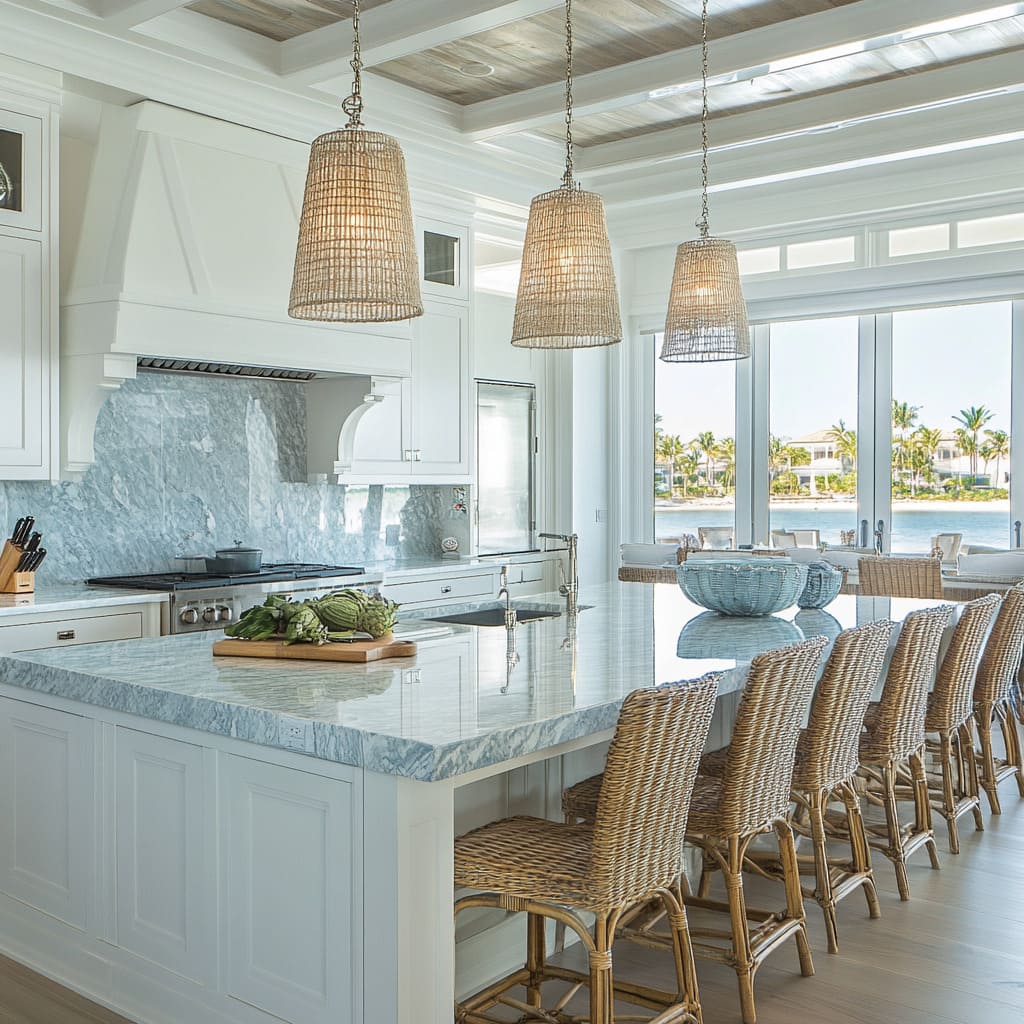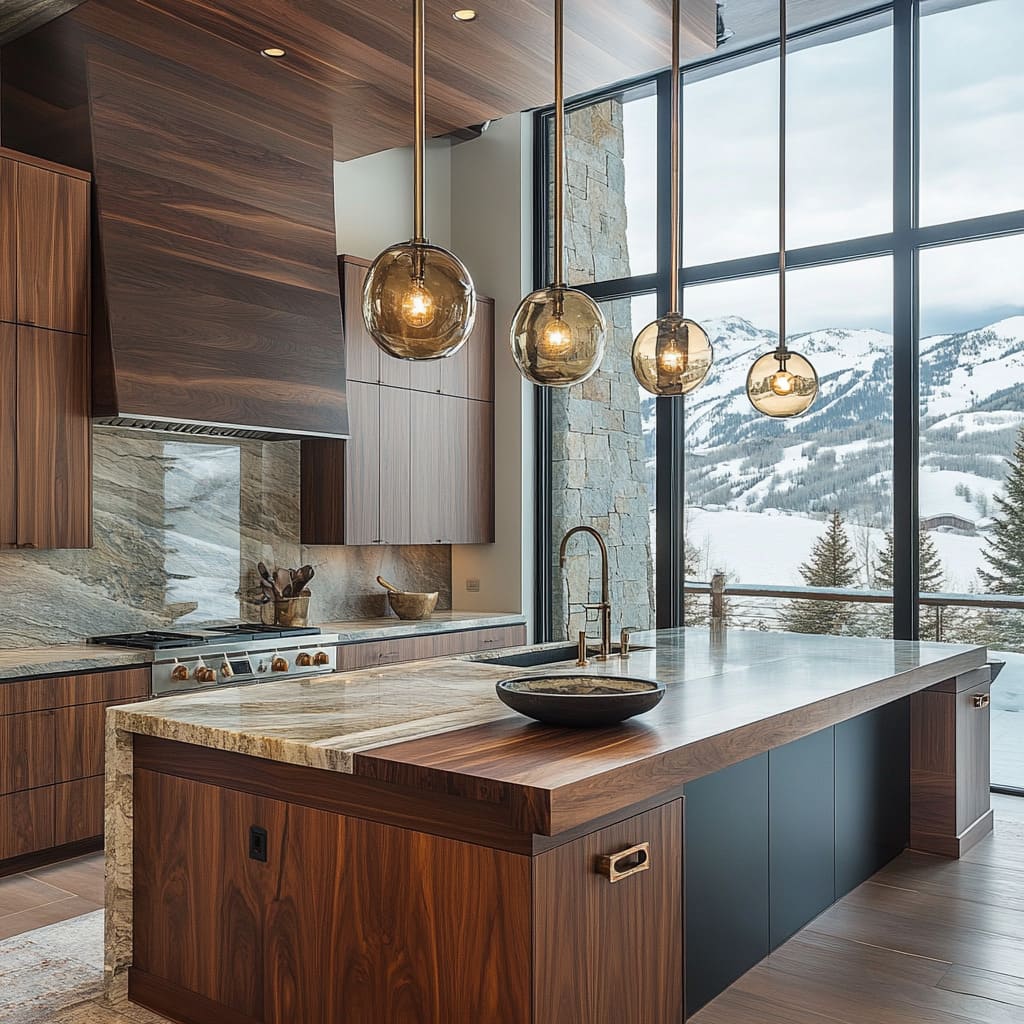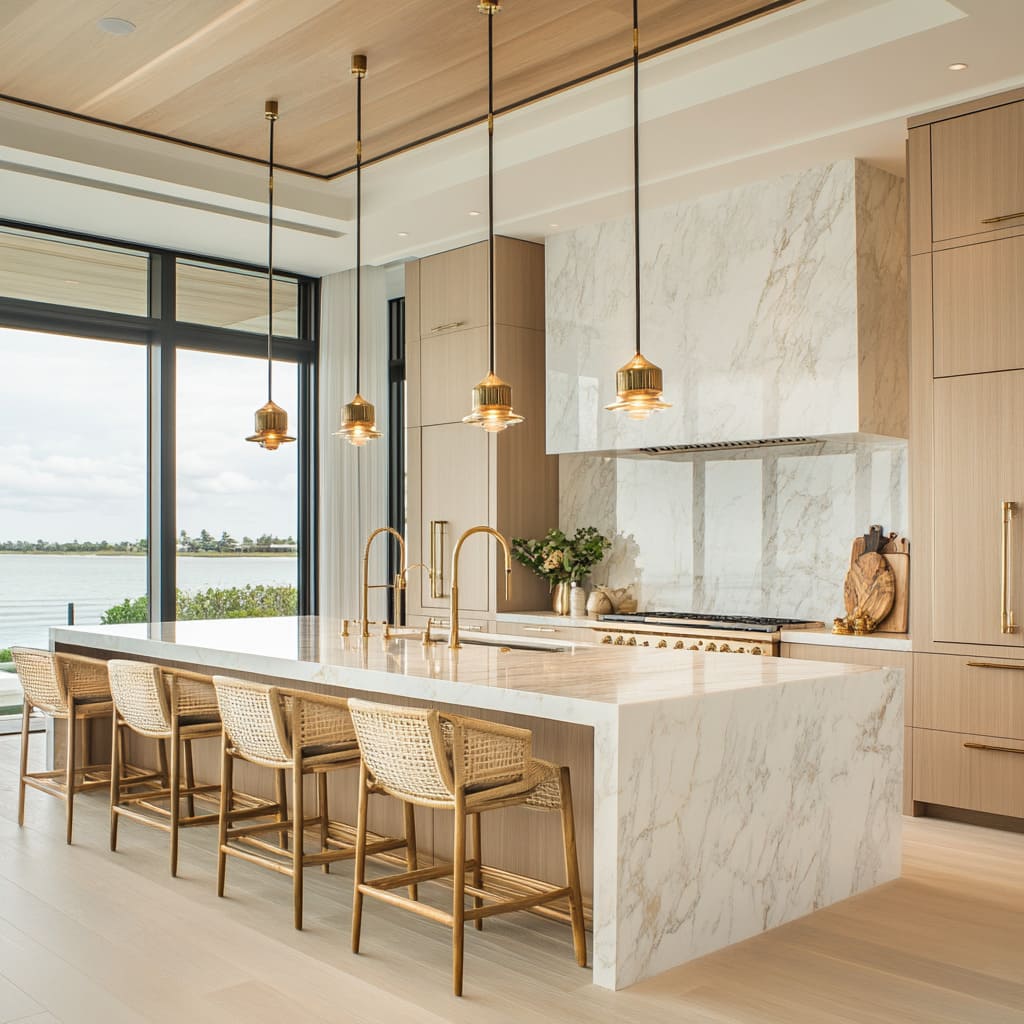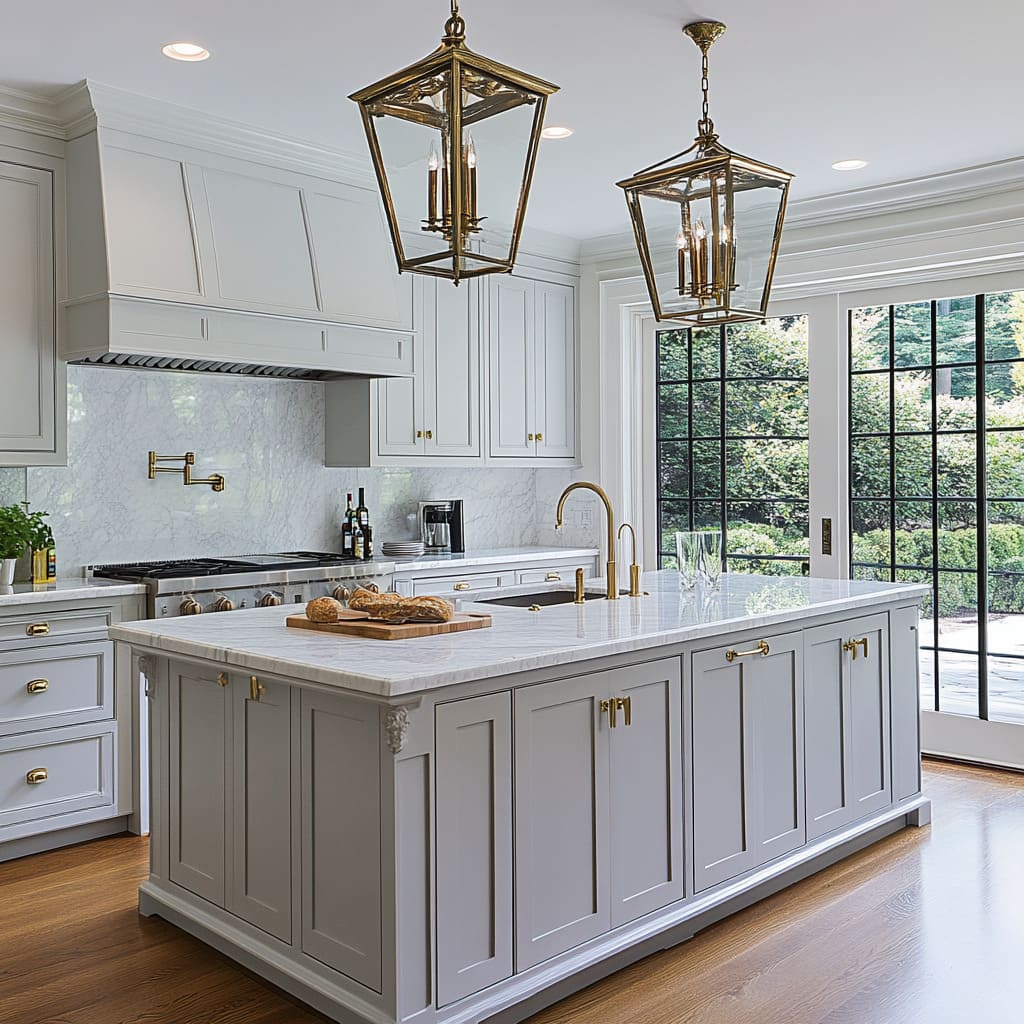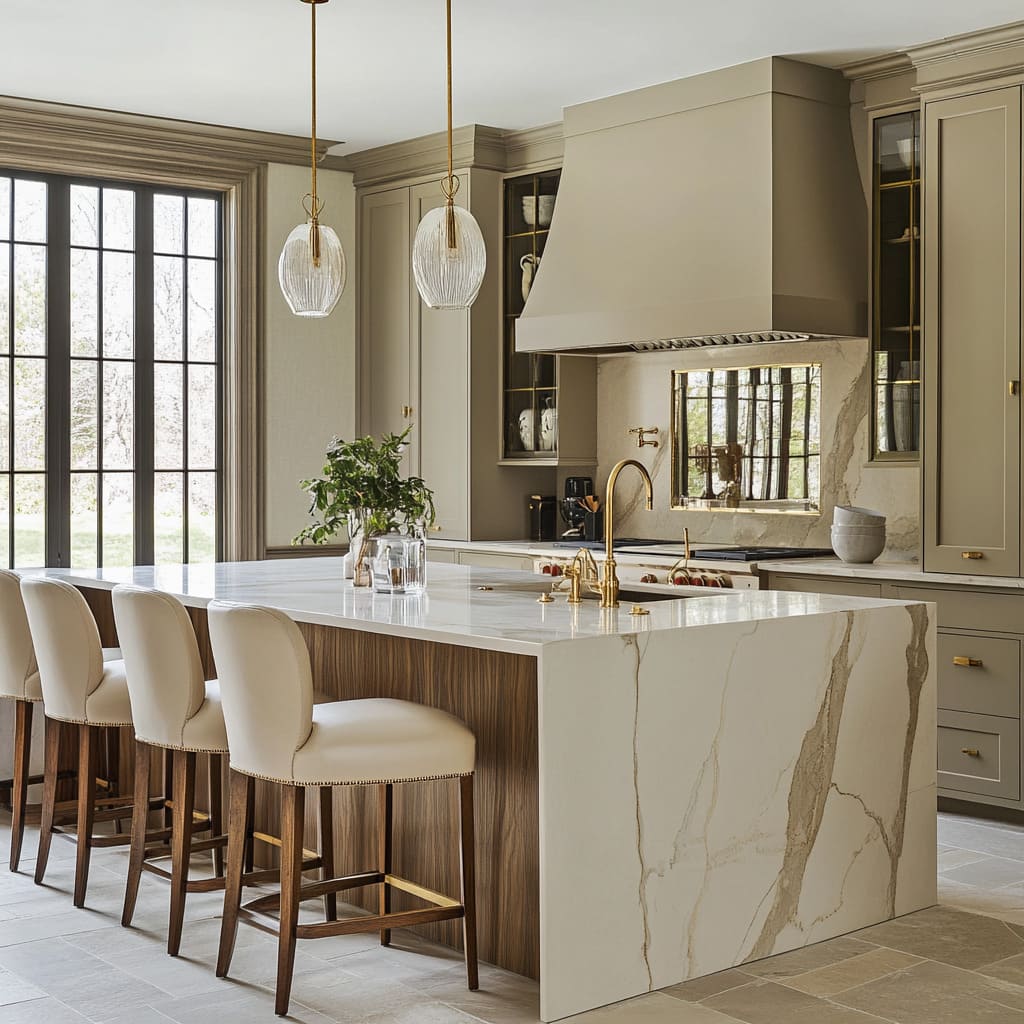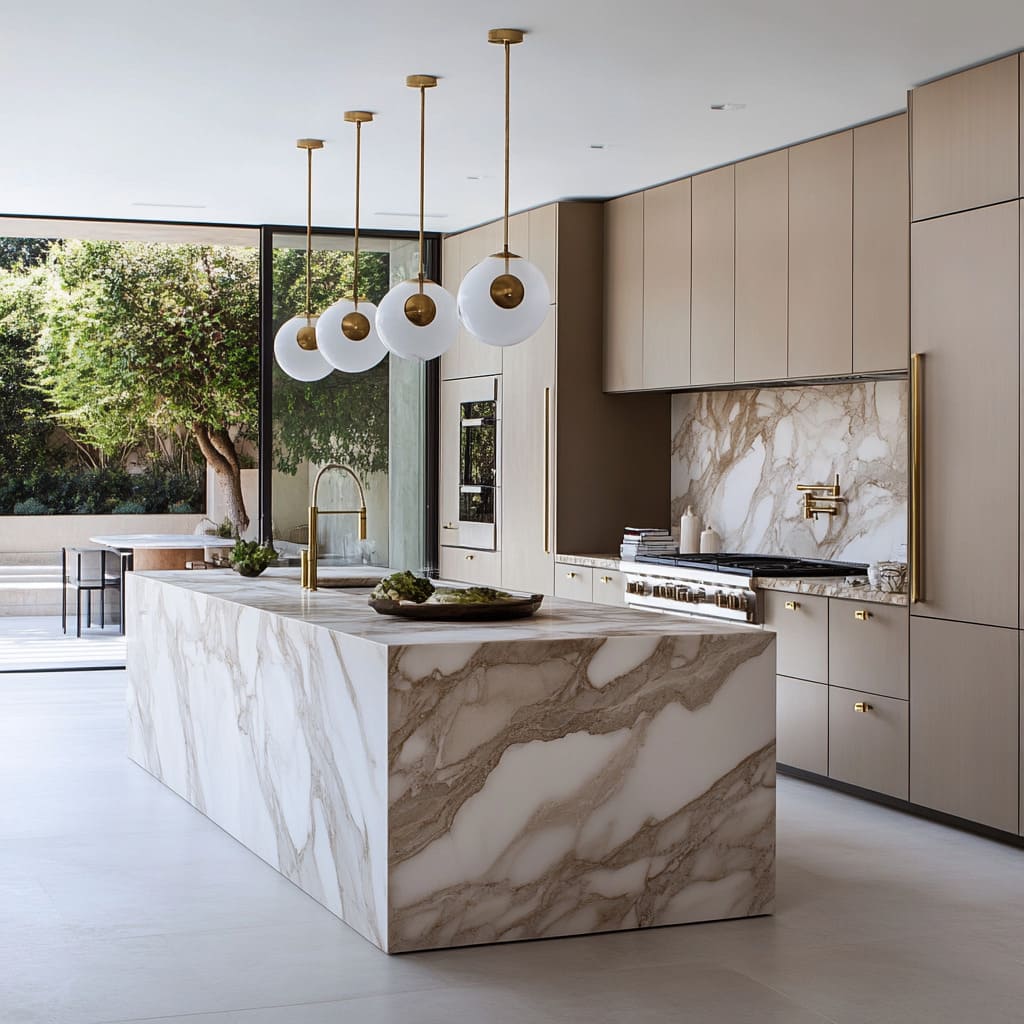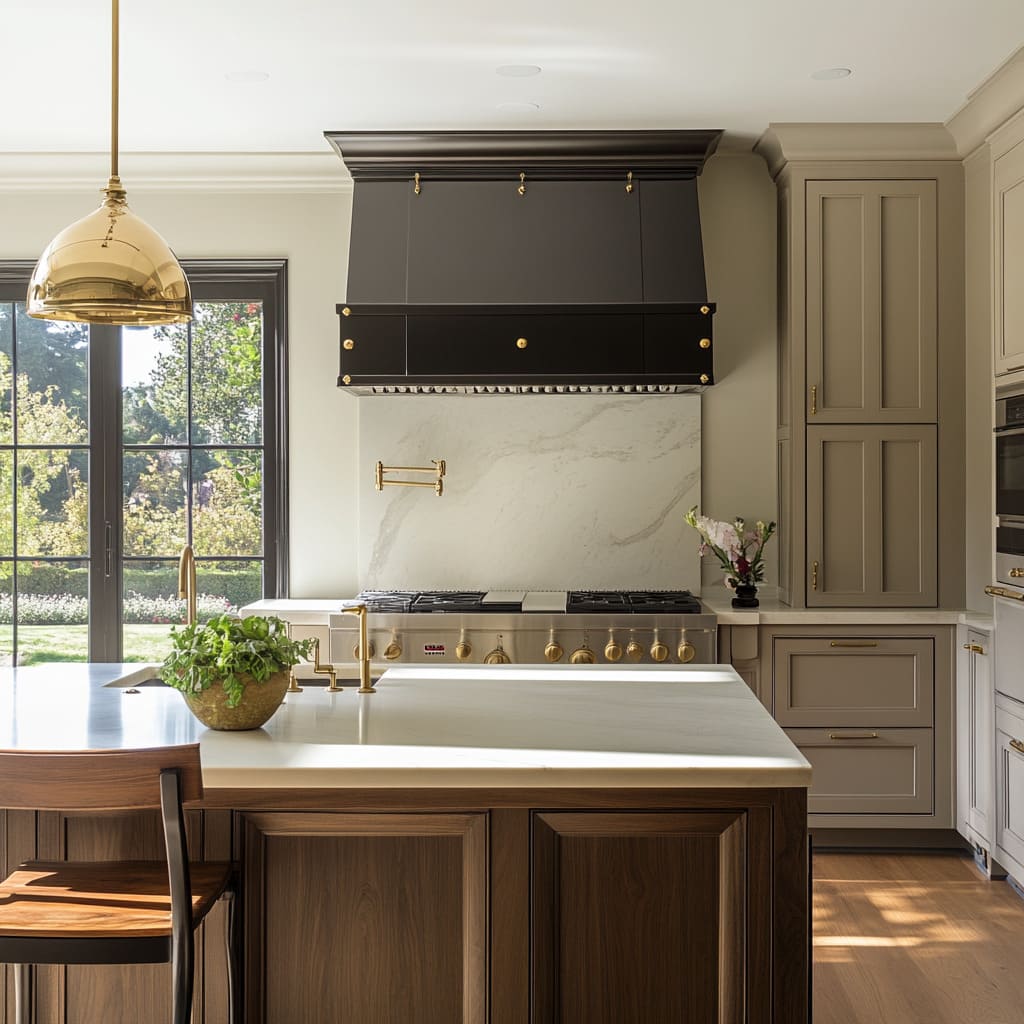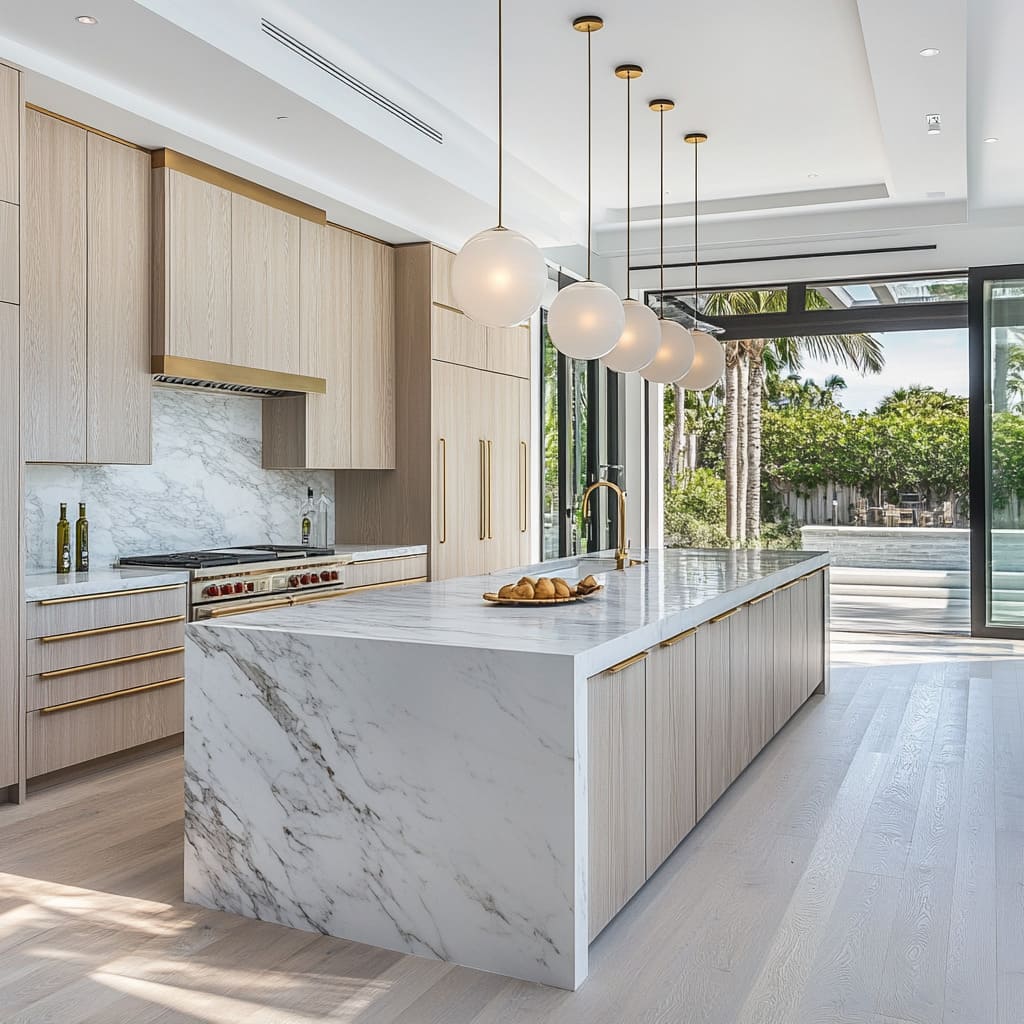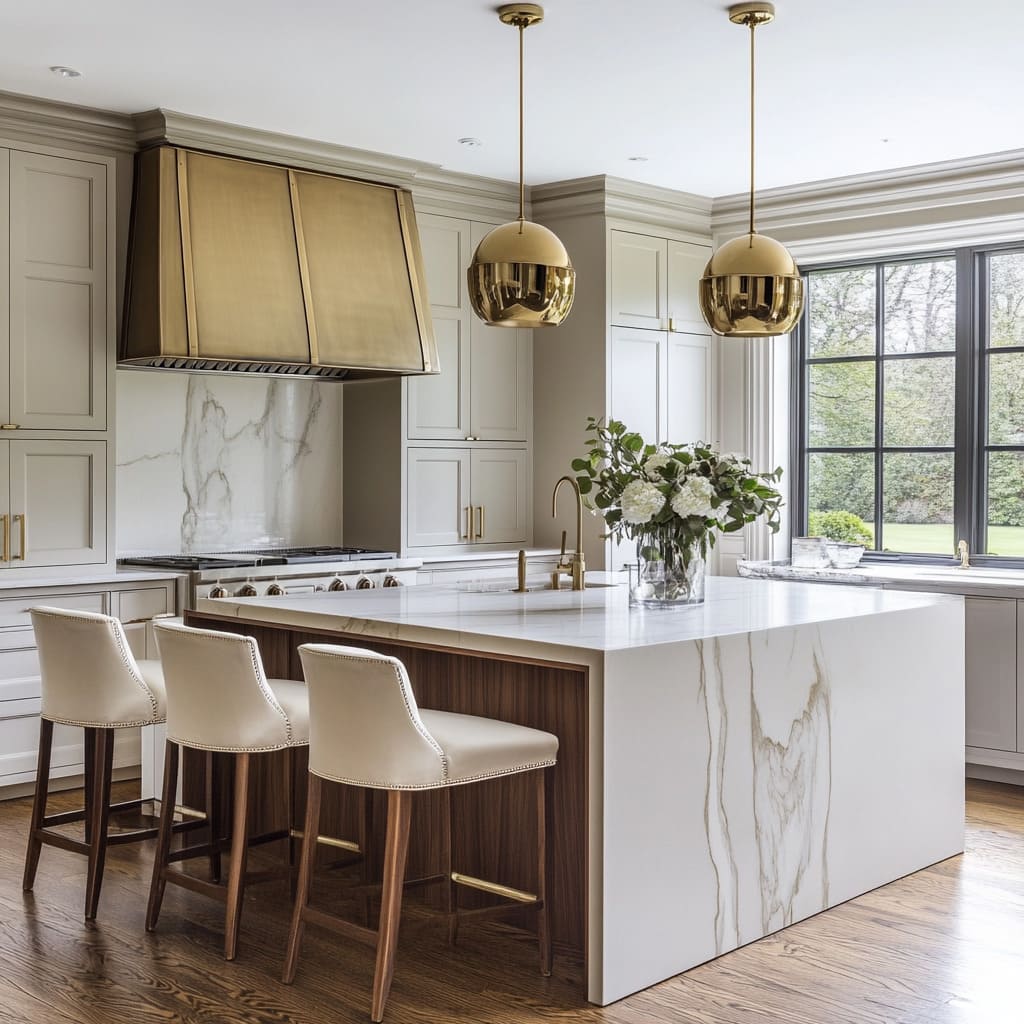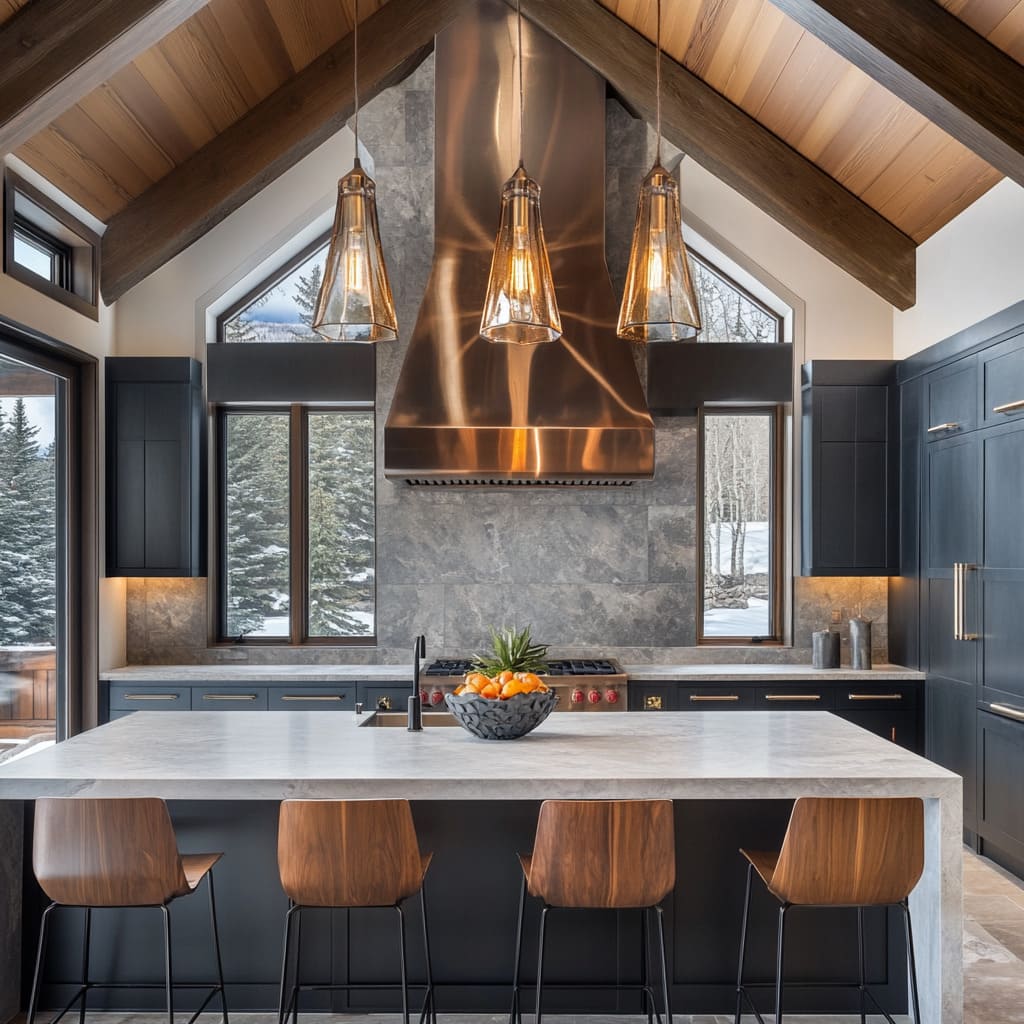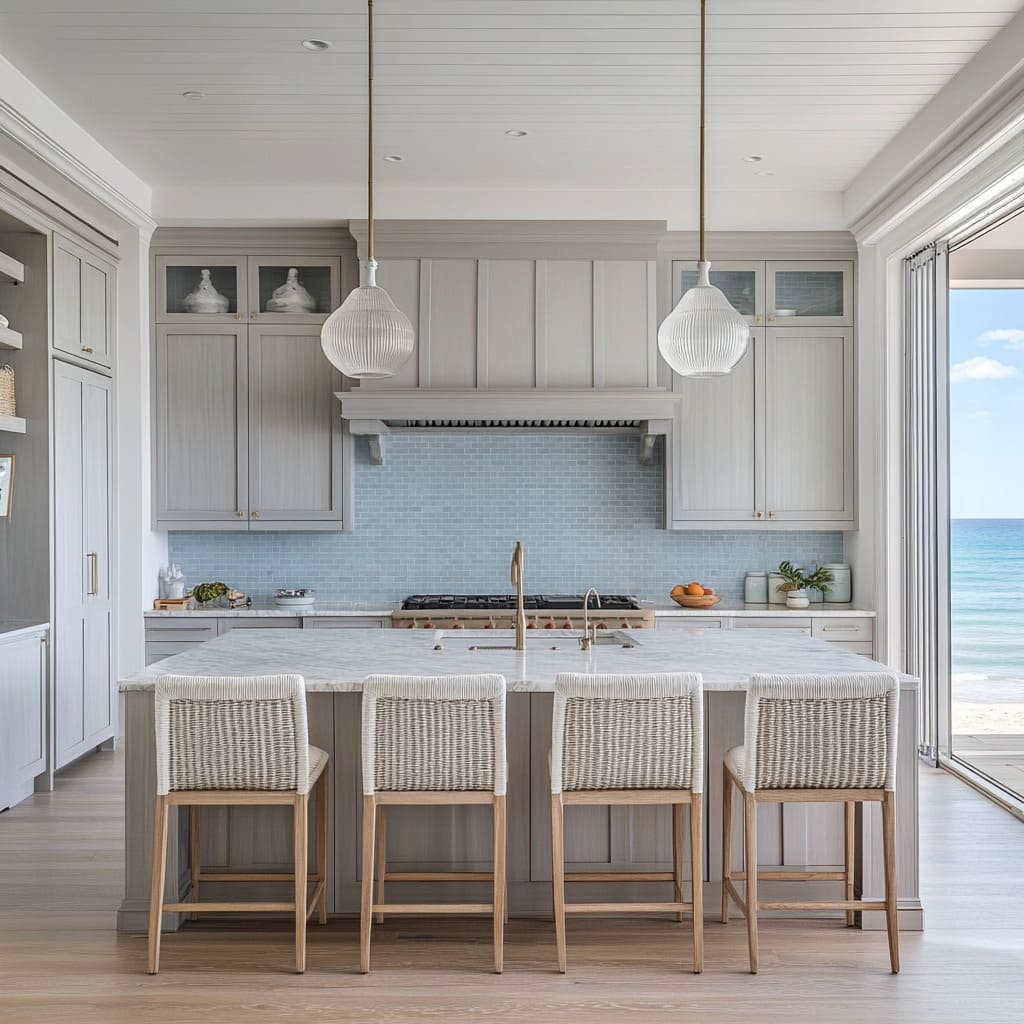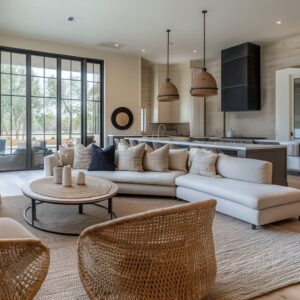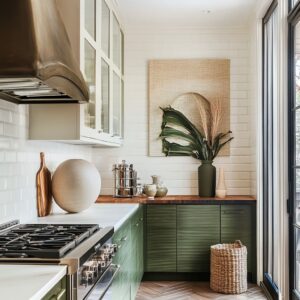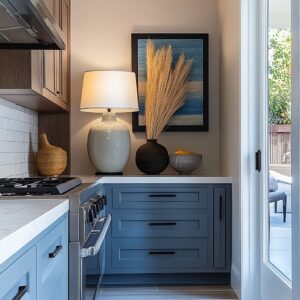A modern elegant kitchen is more than just a place to cook—it’s the heart of the home, where design meets functionality in ways that shape everyday living. In this article, we explore how thoughtfully curated elements like textures, materials, lighting, and layout come together to create kitchens that are both visually stunning and perfectly practical.
Whether inspired by coastal views, urban sophistication, or timeless traditions, these spaces redefine what it means to blend beauty with usability. From carefully chosen color palettes to seamless appliance integration, these kitchens are a masterclass in combining contemporary innovation with enduring style.
Color Theory and Palette Coordination
Dominant Neutrals with Strategic Hues
Neutral tones take center stage in many elegant luxury modern kitchen designs, setting a versatile and sophisticated foundation. Shades like soft beige, cream, charcoal, and gray create a timeless backdrop, adaptable to both minimalistic and more detailed design approaches.
These neutrals are often complemented with thoughtfully chosen accents. Gentle greens or aqua tones, inspired by natural coastal settings, bring an element of tranquility, making the space feel inviting yet refined.
In kitchens with bolder character, darker cabinets—whether matte black or richly lacquered wood—are perfectly offset by the brightness of countertops, often featuring gold or light veining for contrast and visual intrigue.
Harmonizing with Nature
The integration of color often takes inspiration from the surrounding environment, especially in spaces designed to reflect an appreciation for nature. Sage or muted green cabinetry emerges as a popular choice, resonating with the outdoor views of gardens or coastal landscapes.
These hues not only enhance the natural aesthetic but also create a seamless connection between indoor and outdoor spaces. Large windows and expansive glass doors play a pivotal role in amplifying this effect, allowing sunlight and natural surroundings to influence the interior palette.
This balance of colors and materials ensures that the kitchen feels harmonious, grounded, and in tune with its broader environment.
Material and Texture Pairings
Marble and Stone as Focal Points
Stone surfaces dominate the visual hierarchy in nearly every elegant modern kitchen design, lending a sense of permanence and refinement. Marble islands, with their bold and intricate veining, often act as the pièce de résistance of the space, commanding attention and anchoring the design.
Veins in caramel, gold, or soft gray sweep across the surface like brushstrokes, creating movement and adding depth. Beyond the island, stone continues its reign in backsplashes and onyx panels, where dramatic patterns become almost artistic in their own right.
These elements aren’t just functional—they serve as decorative accents that subtly guide the viewer’s gaze from one part of the kitchen to another, creating a harmonious flow throughout.
Wood Tones for Warmth
Wood is a masterful counterbalance to the cooler, polished surfaces of stone. Warm walnut bases, light oak cabinetry, and woven rattan chairs lend an inviting, organic feel to these kitchens.
The interplay between sleek, glossy finishes and natural wood textures creates a tactile richness that invites both visual interest and comfort. In spaces inspired by rustic or mountainous locales, exposed wooden beams and stone walls contribute a deeper connection to the environment, giving the kitchen a unique sense of character.
These wooden elements often echo the broader palette of the home, tying the kitchen into its surroundings with an earthy charm.
Metallic Finishes and Visual Rhythm
The role of metallic accents cannot be overstated—they are the unsung heroes of many modern kitchens. Brass and gold finishes are particularly popular, appearing in everything from understated cabinet pulls to show-stopping focal points like vent hoods or sculptural chandeliers.
These metallic touches add dimension and subtle shine, catching light and reflecting it softly across the room. When used thoughtfully and repeatedly—on faucets, lighting fixtures, and hardware—they establish a visual rhythm that unifies the space.
Importantly, these metallics are rarely overpowering; they act as accents that complement rather than compete with other materials, ensuring a balanced and cohesive aesthetic. This thoughtful pairing of stone, wood, and metallic finishes is what defines the appeal of these kitchens.
The combination creates spaces that feel grounded yet polished, luxurious but approachable, all while maintaining an enduring sense of style. By layering textures and carefully coordinating materials, these designs achieve a harmonious balance that speaks to the artistry of modern kitchen design.
Lighting Design and Fixtures
Layered Illumination
The essence of lighting in a modern elegant kitchen lies in its meticulous layering, balancing functionality with a sense of refined ambiance. At the heart of these designs are multi-tiered lighting solutions that seamlessly blend task-specific illumination with softer, ambient light.
Pendant fixtures, often positioned above islands, provide focused lighting ideal for meal preparation and social gatherings. This is complemented by recessed lighting, which is discreetly embedded along ceiling edges or tucked inside cabinetry.
These hidden sources of light ensure the kitchen is well-lit without creating harsh shadows, making the space both practical and inviting. The layered approach allows for a dynamic environment, easily transitioning from a vibrant cooking zone to a subdued, relaxed setting in the evening.
Chandeliers and Pendant Arrangements
A standout feature in many designs is the careful selection of chandeliers and pendant lights that add character and act as focal points. Oversized lantern pendants offer a dramatic effect, casting an inviting glow across the kitchen island.
In contrast, sleek linear brass tubes contribute a modern touch, emphasizing clean lines and a minimalist aesthetic. Crystal chandeliers add a hint of glamour, their intricate facets refracting light to create playful patterns.
Meanwhile, spherical pendant lamps bring a contemporary flair, balancing form and function effortlessly. The metallic finishes of these fixtures are far from incidental—they are intentionally chosen to echo other prominent features, such as vent hoods or hardware, creating a sense of continuity throughout the space.
Reflective Qualities
The role of reflective surfaces in these kitchens goes beyond mere aesthetics; they are a strategic element in enhancing the overall brightness. Crystal chandeliers, with their shimmering surfaces, amplify the light, creating a radiant effect that fills the room.
Polished metal vent hoods, a frequent feature, not only add visual interest but also subtly reflect and disperse light from overhead sources. High-gloss cabinetry, in shades ranging from pristine white to deep charcoal, further contributes to this effect, bouncing both natural and artificial light to create an impression of spaciousness.
Kitchens with large windows or glass doors particularly benefit from these reflective qualities, as they help diffuse sunlight across the interior, eliminating any dark corners and maintaining a fresh, open feel. These thoughtfully designed lighting schemes are more than just practical—they elevate the aesthetic appeal of the kitchen, emphasizing its unique features while ensuring it remains functional.
By blending layers of light, striking fixtures, and reflective surfaces, these spaces achieve a harmonious balance that defines the modern elegant kitchen. Whether inspired by coastal calm or urban sophistication, these designs demonstrate how lighting can transform a kitchen into a space that is both beautiful and highly functional.
Layout and Compositional Balance
Island-Centric Design
A defining feature in these kitchens is the prominence of the island, a multi-purpose centerpiece that seamlessly blends practicality with style. The island often serves as a workstation equipped with sinks or additional storage while doubling as a social hub where family and guests can gather.
Waterfall edges on countertops create a smooth, continuous flow that visually elongates the structure, giving it a sculptural quality. These islands are frequently paired with thoughtfully chosen barstools that invite casual seating, turning the kitchen into a more relaxed and approachable environment.
Whether upholstered for added comfort or showcasing sleek lines for a contemporary touch, the seating choices reinforce the design’s cohesiveness. The island’s role as a statement piece is amplified by its finishes, such as veined marble or polished quartz, which draw attention while harmonizing with the surrounding elements.
Symmetry and Focal Points
A sense of balance permeates the spatial arrangement of these kitchens, with symmetry acting as a core principle in their layouts. Pendant lights are frequently arranged in precise rows above the island, creating a rhythmic pattern that guides the eye through the space.
Similarly, barstools are grouped to reinforce a sense of visual order, ensuring that the seating arrangement complements the overall design. Major focal points—whether it’s a bold statement backsplash, a vent hood with intricate detailing, or the dynamic veining of a marble countertop—are carefully positioned along the kitchen’s axis.
These features anchor the design, offering points of visual interest while maintaining harmony with other elements. The symmetry in these kitchens isn’t rigid or overwhelming; instead, it subtly underpins the composition, creating a space that feels cohesive and intentional.
Indoor-Outdoor Continuity
Many kitchens in this style emphasize a seamless connection between interior and exterior spaces, taking full advantage of natural light and surrounding views. Large windows, sliding glass doors, or floor-to-ceiling glass panels are common, offering unobstructed panoramas of gardens, mountains, or coastal landscapes.
This design choice not only floods the kitchen with light but also creates a visual dialogue with the outdoors, extending the space beyond its walls. The natural surroundings often influence the interior palette, with earthy tones or muted greens echoing the hues of the environment.
By integrating indoor and outdoor elements, these kitchens become more than just functional spaces; they feel open, expansive, and deeply connected to their settings. Throughout these designs, modern elegant kitchen cabinets play a pivotal role in achieving balance and functionality.
Their clean lines and high-quality finishes ensure they blend seamlessly with the broader layout while providing essential storage. From the symmetry of cabinet arrangements to the way they harmonize with the island and focal points, these cabinets are as much about style as they are about practicality.
Together with the other elements, they contribute to a spatial flow that defines these kitchens as both luxurious and inviting. This approach to spatial layout underscores how thoughtful design choices can transform a kitchen into a harmonious and visually compelling environment.
By centering the island, emphasizing symmetry, and embracing indoor-outdoor continuity, these kitchens achieve a perfect balance of functionality and aesthetic appeal, making them both a joy to use and a pleasure to behold.
Historical and Stylistic References
Transitional Influences
The transitional style is a hallmark of these kitchens, blending elements from the past with contemporary touches to create spaces that feel both familiar and fresh. Ornate molding details frame coffered ceilings, adding depth and architectural interest, while lantern-style pendants provide a nod to timeless lighting traditions.
These classical details are seamlessly juxtaposed with modern finishes, such as sleek handle-less cabinetry and glossy marble surfaces. This duality—where timeless craftsmanship meets cutting-edge materials—ensures the kitchens remain visually engaging and relevant.
The juxtaposition of styles doesn’t clash but rather harmonizes, offering a design that stands the test of time without feeling stagnant or overly steeped in the past. One prominent feature of this transitional approach is the use of statement islands.
While their finishes might include bold, veined marble or polished quartz, their proportions often take cues from classical furniture, with features like beveled edges or paneling that echo historical design. These spaces balance aesthetics with utility, making the kitchens as functional as they are visually striking.
Traditional Allusions
For kitchens drawing inspiration from Georgian or rustic chalet aesthetics, the craftsmanship is immediately evident in the finer details. Carved legs on kitchen islands bring to mind the artistry of handmade furniture, adding a sense of character to the otherwise streamlined layouts.
Tufted barstools with decorative nailhead trim contribute a touch of elegance, while intricately designed moldings further emphasize the connection to traditional styles. These elements create a warm and inviting atmosphere, celebrating the artistry of the past while ensuring the spaces remain functional for modern living.
However, these kitchens do not rely solely on nostalgia. Modern metal accents—such as brass hardware or steel light fixtures—are incorporated with intention, preventing the designs from feeling dated.
Updated lighting, such as linear pendants or recessed fixtures, adds a contemporary flair, subtly grounding the historical elements in a more current context. This fusion highlights the versatility of traditional details when paired with thoughtful, modern updates.
Minimalist or Urban Approaches
Kitchens located in penthouses or inspired by coastal simplicity often take a minimalist approach, prioritizing clean lines and an uncluttered aesthetic. Smooth surfaces dominate these designs, with integrated appliances disappearing into cabinetry for a sleek, unified appearance.
Handle-less cabinetry reinforces the streamlined effect, offering a minimalist design that lets the quality of materials take center stage. In these spaces, the island often becomes the standout feature.
Whether crafted from dramatic onyx or marble with bold veining, it serves as both a functional hub and a decorative focal point. Its sculptural presence anchors the room, making it the defining statement in an otherwise understated environment.
For coastal designs, the palette leans toward soft neutrals, allowing the natural light and outdoor views to shine, while urban settings might embrace darker tones or high-gloss finishes to reflect the energy of the city. The minimalist approach doesn’t sacrifice warmth.
Textured stone and subtle metallic finishes add depth, ensuring that even the most pared-back designs remain inviting. The integration of these stylistic choices highlights how versatility and attention to detail can cater to various lifestyles and settings, making each kitchen as individual as the homeowners themselves.
Through their nuanced nods to historical and modern influences, these kitchens manage to evoke familiarity while maintaining a forward-thinking edge. Whether through transitional design, traditional craftsmanship, or minimalist elegance, these spaces offer a rich blend of stylistic references that make them unforgettable.
Texture and Pattern Analysis
High Gloss vs. Matte Contrasts
A defining feature of many contemporary kitchens is the deliberate use of contrasting textures to highlight the unique properties of different materials. High-gloss finishes, often seen in lacquered cabinetry or polished metal accents, play a crucial role in reflecting light and enhancing the brightness of the room.
These reflective surfaces create a striking balance when juxtaposed against matte or textured materials, such as natural wood or stone. For instance, the soft sheen of a glossy cabinet can amplify the depth of grainy wood flooring or the subtle texture of a marble backsplash, ensuring each material is given its moment to stand out.
The thoughtful integration of these contrasts does more than elevate aesthetics; it introduces a tactile richness. Smooth, mirrored cabinetry provides a sleek, almost futuristic feel, while the grain of natural oak or the veining in a marble countertop brings warmth and grounding to the design.
This careful interplay of gloss and matte not only emphasizes visual depth but also enhances the overall sensory experience of the kitchen, making it a space that feels luxurious yet approachable. In homes with open layouts, this contrast can serve as a subtle divider, visually separating the kitchen from adjoining areas without the need for walls.
Use of Repetition
Repetition emerges as a subtle yet powerful tool in the design of these spaces, fostering cohesion and a sense of visual rhythm. One particularly striking example is the continuation of marble veins across multiple surfaces, such as a backsplash flowing seamlessly into the countertop.
This consistent use of pattern ensures that the natural stone takes on a unifying role, tying the various elements of the kitchen together. Similarly, metallic accents, such as gold trim along cabinetry edges or light fixtures, can echo through the design, creating a thread of continuity that subtly guides the eye.
Despite this focus on repetition, variety is not sacrificed. Kitchens often incorporate textural contrasts to prevent monotony and to add layers of interest.
For instance, while a sleek marble island may dominate the visual focus, the addition of woven rattan barstools or subtly textured tile backsplashes softens the overall effect, introducing a sense of balance. The beauty of this approach lies in its ability to maintain cohesion without feeling rigid or overly uniform.
In some designs, patterns serve a functional purpose, such as defining zones within the space. For example, a bold geometric tile on the floor beneath the island can visually separate it from the rest of the kitchen, adding depth and dimension.
This thoughtful use of pattern ensures that the design feels intentional and dynamic, while still remaining harmonious.
Modern Elegant Kitchen Design as a Whole
In combining textures and patterns, these kitchens achieve an aesthetic that is both sophisticated and inviting. High-gloss surfaces inject a contemporary flair, while matte finishes and natural textures ground the space in a sense of timelessness.
The careful repetition of elements—whether through veining, metallic details, or complementary materials—creates a visual rhythm that feels effortless and refined. Each design not only captures the essence of a modern elegant kitchen design but also reflects the individuality of the homeowners, balancing bold statements with understated details to create spaces that are truly one-of-a-kind.
Whether inspired by urban penthouses or coastal retreats, these kitchens demonstrate the transformative power of texture and pattern. Through thoughtful contrasts and harmonious repetition, they become more than functional spaces—they evolve into artful compositions, seamlessly integrating beauty and practicality in ways that are both inspiring and attainable.
Lighting as a Sculptural Element
Sculptural Pendants
Lighting, in many of these designs, transcends its functional role, becoming a defining feature of the kitchen’s aesthetic. Sculptural pendant fixtures often dominate the visual field, hanging prominently above islands or dining spaces.
These pendants are more than mere light sources—they function as statement pieces, akin to art installations. Elongated designs or oversized geometric shapes, crafted from polished metals or frosted glass, bring dimension to the room, creating focal points that capture attention immediately upon entry.
For example, elongated brass pendants with asymmetrical designs create an almost architectural effect, casting intricate shadows and enhancing the overall visual texture of the kitchen. Their placement is equally intentional, with even spacing above islands to create symmetry or asymmetry, depending on the desired tone.
In open-concept layouts, sculptural pendants serve as subtle dividers, marking the kitchen’s presence without creating physical barriers. This fusion of form and function elevates the concept of lighting from a practical necessity to an essential design feature.
Crystal and Glass Accents
The use of crystal and glass in lighting design amplifies the luxurious feel of these kitchens, introducing an element of opulence through material choice. Crystal chandeliers, for instance, are a popular addition to more classical or transitional kitchens, offering a striking contrast to sleeker, modern finishes.
Each crystal catches and refracts light, creating delicate rainbows and sparkles that dance across the room, particularly when paired with ample natural sunlight or strategically placed recessed lighting. This interplay of light and material adds depth and a sense of motion to the overall composition.
Meanwhile, frosted or smoked glass globes provide a softer alternative. These fixtures diffuse light more subtly, enveloping the kitchen in a warm glow rather than sharp beams.
They pair beautifully with reflective elements like polished brass faucets, glossy marble islands, or mirrored backsplashes, creating layers of reflection that deepen the visual impact. The soft interaction between frosted glass and external light sources contributes to the refined and sophisticated atmosphere of an elegant luxury modern kitchen, seamlessly blending functionality with high-end aesthetics.
Dynamic Interaction with Surroundings
In many cases, the lighting fixtures themselves interact dynamically with the kitchen’s other design features. Metallic finishes on pendants and chandeliers, for example, are often chosen to complement hardware or vent hood materials, ensuring visual cohesion.
Brass and gold remain frequent choices, their warm tones harmonizing with wood cabinetry, stone surfaces, or neutral palettes. In kitchens where dark tones dominate—such as matte black cabinetry or dark-stained wood—lighting provides a necessary balance, offsetting these deeper hues with glints of light and metallic sheen.
In spaces with large windows or glass walls, lighting fixtures benefit from external influences as well. During the day, sunlight interacts with reflective or transparent elements, amplifying brightness and enhancing the room’s natural energy.
By night, these fixtures take on a more dramatic role, casting their own glow and transforming the kitchen into an ambient retreat. This duality—how lighting responds to and transforms its environment—adds to the overall appeal, making it as much a part of the space as the marble countertops or modern cabinetry.
Theatrical and Functional Balance
A well-designed kitchen often strikes a balance between the theatrical and the functional, and lighting is at the heart of this equilibrium. Sculptural pendants and crystal chandeliers make bold design statements, commanding attention and setting the tone for the space.
Yet, they are also carefully calibrated to ensure they meet practical needs, providing adequate illumination for food preparation, dining, or entertaining. The thoughtful placement and selection of materials ensure that even the most dramatic fixtures maintain their utility, proving that luxury can coexist with practicality in these meticulously curated spaces.
In essence, lighting becomes the defining element that ties together every other feature in the room. It complements the stone textures, highlights the intricate patterns in backsplashes, and casts warmth on sleek cabinetry, bringing a sense of cohesion and completion.
In an elegant kitchen, lighting doesn’t merely illuminate—it shapes, transforms, and completes the story of the space.
Cohesion Between Fixtures and Hardware
Matching Metal Accents
A defining hallmark of an elegant modern kitchen is the seamless integration of metal finishes across fixtures and hardware. Once a particular metal is chosen—whether it’s brushed gold, polished nickel, or antique brass—it is thoughtfully echoed throughout the kitchen to create a unified style.
This level of consistency provides not just a polished aesthetic but also an underlying sense of order and intentionality. For instance, a brushed gold finish might appear on cabinet handles, sink faucets, and pendant light frames.
Even smaller details, like the legs of barstools or trim on a range hood, are often designed to match, ensuring that no element feels out of place. This careful repetition of material choices adds depth to the space without overwhelming it.
In some kitchens, even the metallic rims of open shelving or decorative bowls are chosen to complement the primary metal tone, creating subtle layers of cohesion. This harmony in finishes also extends to lighting fixtures.
Pendants or chandeliers with metallic accents often mirror the tone of drawer pulls or appliance knobs, unifying disparate components into a singular style narrative. These small details, though often overlooked, play an essential role in achieving a balanced and visually satisfying design.
By ensuring that every piece—from the largest to the smallest—aligns with the chosen material palette, the overall kitchen feels curated and complete.
Integrated Appliances
The integration of appliances is another cornerstone of these sophisticated kitchens. Traditional appliances, with their protruding designs and visible branding, can sometimes disrupt the visual flow of a well-planned kitchen.
However, in these spaces, cabinetry panels are used to disguise refrigerators, dishwashers, and even microwaves, resulting in a sleek and uninterrupted aesthetic. This approach highlights the balance between functionality and style.
Modern kitchen technology is seamlessly incorporated without drawing unnecessary attention. For example, a refrigerator might appear as an extension of the surrounding cabinetry, its exterior indistinguishable from the adjacent storage spaces.
Similarly, dishwashers and built-in wine coolers are often concealed beneath custom panels, ensuring they blend seamlessly into the overall composition. This design choice also supports the kitchen’s role as a multifunctional space.
In homes where the kitchen transitions into open living or dining areas, the absence of visible appliances helps maintain a cohesive aesthetic. The result is a refined environment where utility and beauty coexist, allowing the focus to remain on the textures, materials, and finishes that define the space.
Balancing Modernity and Warmth
While the emphasis on metal accents and integrated appliances lends a contemporary feel, these kitchens do not sacrifice warmth or approachability. The metal finishes are often paired with softer elements, such as natural wood cabinetry or marble countertops with organic veining.
This pairing ensures that the kitchen feels inviting, avoiding the sterility that overly modern designs can sometimes evoke. Moreover, the integration of appliances allows for a streamlined and clutter-free look, emphasizing the beauty of the materials and textures.
This approach creates an environment where each element contributes to the overall design, rather than competing for attention. Whether it’s the gleam of a polished brass faucet or the understated elegance of a hidden dishwasher, every detail is carefully considered.
Reflecting Regional Inspirations
Inspiration from different regions further enhances the character of these kitchens. For example, in coastal-inspired designs, brushed nickel or stainless steel accents are often chosen to evoke the hues of the ocean and sky.
In contrast, brass and gold finishes are prevalent in kitchens influenced by traditional Southern or Mediterranean styles, where warmth and richness are central themes. This adaptability of metal finishes and appliance integration ensures that the kitchens not only reflect the homeowner’s style but also resonate with their surroundings.
Unified Yet Flexible
Ultimately, the thoughtful coordination of fixtures and hardware is about creating unity while allowing for flexibility. By choosing a single metal finish and repeating it across various elements, these kitchens achieve a level of harmony that feels effortless yet deeply intentional.
When paired with integrated appliances, the result is a space that prioritizes both form and function, presenting a vision of modern design that is as practical as it is beautiful. Every detail, from a discreetly hidden dishwasher to the matching metallic trim of a pendant light, works together to craft a cohesive and inspiring kitchen environment.
Seating Strategies
Comfort Plus Style
Seating in modern kitchens serves as both a functional necessity and a design statement. The choice of barstools and chairs leans heavily on materials that strike a balance between luxury and practicality.
Soft, inviting textures like velvet and leather dominate, offering a tactile richness that complements the harder surfaces of countertops and cabinetry. Velvet, with its gentle sheen and smooth touch, introduces an air of sophistication, while leather offers a timeless appeal and durability that withstands daily use.
In many designs, these lush materials are paired with structured metal frames, often finished in gold, brass, or black, providing a clean contrast to the softness of the upholstery and subtly echoing metallic accents in the space, such as hardware or light fixtures. Nailhead trim is a frequent detail, outlining chair edges with a touch of refinement and connecting the seating to the broader decorative narrative of the kitchen.
Wood-based seating is another common feature, particularly in kitchens with a more organic or transitional style. The grains and finishes of wood chairs or stools often echo the tones of the cabinetry or flooring, creating a sense of cohesion across the entire space.
Whether polished for a sleek finish or left slightly textured for a rustic charm, its presence adds warmth and a grounded feel to the kitchen’s design.
Placement and Layout
The arrangement of seating around the kitchen island is not just functional but strategic, with a focus on encouraging social interaction and seamless usability. The island often acts as the central hub of the kitchen, serving as a space for dining, casual conversations, and collaborative cooking.
Seating placement is carefully thought out to enhance this versatility, ensuring that guests and family members can interact comfortably while meals are prepared. In kitchens with a more formal aesthetic, barstools or chairs are often symmetrically aligned, creating a sense of order and balance.
This symmetry is especially impactful in spaces with a minimalist or structured design, as it reinforces the clean, deliberate lines of the cabinetry, countertops, and lighting fixtures. Each chair or stool becomes a deliberate element in the overall composition, adding to the polished atmosphere.
In contrast, more casual or family-focused kitchens may opt for a slightly varied seating layout. Stools might be spaced unevenly, or chairs of slightly different heights or designs could be incorporated.
This subtle variation injects a relaxed vibe, making the kitchen feel approachable and lived-in. It’s a strategy often used in kitchens that prioritize warmth and a welcoming atmosphere over formality.
Heightened Functionality
Beyond aesthetics, seating in these kitchens is designed with usability in mind. Adjustable-height stools are a popular choice in multi-generational households, allowing users to customize their seating experience.
Padded seats and backs further ensure comfort, even during extended use, making the kitchen an inviting place to linger. In spaces where the island doubles as a dining table, seating is often selected to transition easily between casual and formal settings.
Stools with backrests and armrests are ideal for longer meals or gatherings, offering support and encouraging relaxation. Meanwhile, the use of swivel stools adds an element of convenience, allowing users to pivot effortlessly between conversations and activities.
Regional Inspirations in Design
The design of seating can also draw inspiration from the surrounding environment or cultural influences. For example, in coastal kitchens, rattan or wicker stools are often chosen to evoke the relaxed, natural vibe of beachside living.
These materials pair seamlessly with light wood tones and soft blue or green cabinetry, reinforcing the connection to the ocean and landscape. In urban kitchens, seating tends to favor sleek, modern lines, with minimal embellishments and a focus on functionality.
Here, black leather or metal stools dominate, aligning with the streamlined, industrial feel often found in city-inspired spaces. Each region adds its own twist to the seating choices, tailoring them to both the aesthetic and lifestyle needs of the homeowners.
The Impact of Materials and Finishes
The finishes on seating often play a crucial role in the kitchen’s overall visual narrative. Matte black or brushed gold frames create a striking contrast to glossy marble countertops or polished wood floors.
Similarly, stools with upholstered seats in muted tones, such as taupe, gray, or deep green, blend harmoniously into the kitchen’s palette, ensuring the seating enhances rather than overpowers the surrounding design elements. This thoughtful attention to detail ensures that every element, from the curvature of the chair backs to the stitching on the cushions, contributes to the overall cohesion of the kitchen.
Whether sleek and modern or warm and traditional, the seating feels as though it belongs, tying together the various design elements into a unified whole.
Social and Functional Integration
Ultimately, the seating in these kitchens goes beyond mere practicality. It’s an integral part of how the kitchen functions as a social space.
Whether it’s children doing homework while parents cook dinner or guests gathering for casual drinks and conversation, the seating arrangement facilitates interaction and comfort. In this way, it transforms the kitchen into more than just a place to prepare food—it becomes the true heart of the home.
Closing Observations
These kitchens represent the pinnacle of design, combining timeless elements with innovative features to create spaces that are as functional as they are visually captivating. By balancing neutral palettes with strategically placed metallic accents and bold stone features, each design achieves an air of sophistication without sacrificing warmth or approachability.
Neutral backgrounds—whether in shades of soft beige, creamy whites, or muted grays—set the stage for more dramatic elements, like veined marble islands or sculptural brass lighting. This balance ensures the kitchens feel grounded while still drawing the eye to key focal points.
Repetition plays a vital role in unifying each design. Whether it’s the symmetry of pendant lighting above an island, the consistency of hardware finishes across cabinetry, or the flowing continuity of stone veining from countertops to backsplashes, these repeated elements create a sense of rhythm and cohesiveness.
Such visual consistency allows the designs to feel intentional and complete, guiding the viewer seamlessly through the space.
At the same time, the incorporation of natural textures ensures these kitchens avoid feeling too sterile or overly polished. Elements like exposed wooden beams, rattan seating, or rustic stone walls inject warmth, grounding the designs in a sense of comfort and familiarity.
These tactile materials soften the sleekness of glossy cabinetry or reflective metallic finishes, creating spaces that feel welcoming and approachable. One of the standout achievements of these kitchens is their ability to merge classical and contemporary design influences.
Traditional details, such as decorative moldings, coffered ceilings, or lantern-style chandeliers, provide a sense of history and elegance. These are expertly paired with clean, modern lines and integrated technology, such as hidden appliances or handle-less cabinetry, ensuring the kitchens remain functional for today’s lifestyles.
This blending of old and new results in designs that feel timeless yet current, appealing to a wide range of tastes.
Every detail in these kitchens contributes to their overall success. Lighting plays a transformative role, elevating the mood of the space and highlighting its best features.
Metallic finishes—whether in gold, brass, or nickel—are carefully chosen to enhance cohesion, appearing in hardware, fixtures, and decorative accents. Meanwhile, innovative uses of stone, from dramatic waterfall islands to full-height backsplashes, showcase the natural beauty of materials while doubling as works of art.
These kitchens go beyond the surface, offering more than just visual appeal. They embody thoughtful design principles, where every choice—be it in color, material, or layout—serves both an aesthetic and practical purpose.
The result is a multi-dimensional space that accommodates cooking, socializing, and everyday living with equal ease.
Collectively, these designs stand as a testament to the power of harmony and balance. By layering textures, coordinating materials, and introducing subtle yet impactful consistencies, they transform kitchens into stunning showcases of modern luxury infused with timeless charm.
These spaces not only celebrate high design but also emphasize the importance of functionality, proving that kitchens can be both beautiful and indispensable in the modern home.
